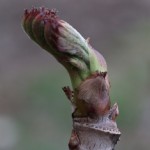 Made of developing tissues, buds and young shoots are a true concentrate of the plant’s energy and vitality. They also contain many active principles that are no longer present when the plant is fully developed. Zymotherapy is a branch of phytotherapy that uses the therapeutic properties and energy from enzymatic fermented buds and young shoots of trees, shrubs and herbs. They are gathered in the spring, at a key stage of the natural growth cycle, and freshly prepared in a fermentation process. To create the highest level of therapeutic compounds, select ingredients are fermented under highly controlled processes. But this is no ordinary fermentation. When used in novel, new ways, the result can be revolutionary. This explains the wide range of applications and effectiveness of Zymotherapy remedies.
Made of developing tissues, buds and young shoots are a true concentrate of the plant’s energy and vitality. They also contain many active principles that are no longer present when the plant is fully developed. Zymotherapy is a branch of phytotherapy that uses the therapeutic properties and energy from enzymatic fermented buds and young shoots of trees, shrubs and herbs. They are gathered in the spring, at a key stage of the natural growth cycle, and freshly prepared in a fermentation process. To create the highest level of therapeutic compounds, select ingredients are fermented under highly controlled processes. But this is no ordinary fermentation. When used in novel, new ways, the result can be revolutionary. This explains the wide range of applications and effectiveness of Zymotherapy remedies.
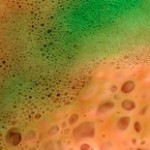 Select ingredients are produced through the proprietary fermentation process to make therapeutic properties more available to the body. Fermentation is a natural method of concentrating raw food materials, and preserving them. The phytocompounds from the fermented ingredients are not only retained but enhanced, making them more easily absorbed by your body.
Select ingredients are produced through the proprietary fermentation process to make therapeutic properties more available to the body. Fermentation is a natural method of concentrating raw food materials, and preserving them. The phytocompounds from the fermented ingredients are not only retained but enhanced, making them more easily absorbed by your body.
Unlike ordinary herb processing, fermentation also improves the overall therapeutic value of the fresh buds adding new nutrients and making them easy to digest. More importantly, fermentation reduces toxins and anti-nutritive byproducts. This beneficial result is greatly facilitated when very pure plant enzymes are used in the fermentation process. The fermented phyto-dense formula of the ingredients of Zymotherapy formula creates a unique mix of health benefits found in no other way. Zymotherapy also uniquely contributes to the growth of your helpful intestinal bacteria while inhibiting the growth of harmful intestinal bacteria.
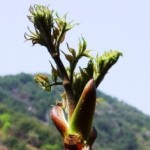 Buds and young shoots are made of embryonic tissues and enclose all the properties and energy of the future plant. In addition to containing vitamins, oligo-elements, enzymes and minerals, buds and young shoots are richer in nucleic acids and growth hormones than other plant tissues. They also contain other active substances, such as auxins and gibberellins, which start to disappear after a plant reaches a certain point in its growth. Those are Plant Growth Regulators with specific actions, acting in low concentrations and regulating cell enlargement, division, differentiation, organogenesis, aging and dormancy.
Buds and young shoots are made of embryonic tissues and enclose all the properties and energy of the future plant. In addition to containing vitamins, oligo-elements, enzymes and minerals, buds and young shoots are richer in nucleic acids and growth hormones than other plant tissues. They also contain other active substances, such as auxins and gibberellins, which start to disappear after a plant reaches a certain point in its growth. Those are Plant Growth Regulators with specific actions, acting in low concentrations and regulating cell enlargement, division, differentiation, organogenesis, aging and dormancy.
Given that they are extracts of developing tissues, Zymotherapy remedies combine the properties of the whole plant, including the flowers, the leaves, the fruits, the sapwood, and the rootlets. For example, the Linden Tree (TiliaTomentosa) Zymotherapy product not only possesses the sedative properties of the flowers, but also the purifying and diuretic properties of the sapwood. The same is true of the Hawthorn bud (Crataegus Oxyacantha) which has the properties of the flower which regulate cardiac rhythm and relieve palpitations, and those of the fruit which maintain heart muscle vitality.
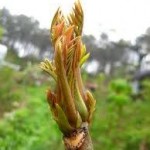 People who get to know about Zymotherapy for the first time often ask questions such as “Can a certain disease be cured?” For instance, they ask “Can a headache or allergic rhinitis be healed?” Furthermore, they ask “Can cancer be cured?” However, these questions are from those who are familiar with Western medical science for a long time. The origin of disease is unbalance between Yin and Yang. Therefore, balancing between Yin and Yang is the 1st step of cure. For instance, in the case of rhinitis, it can be cured by directly dealing with the part that causes pain. However, from a fundamental approach, it deals with large intestine which is connected to the lung. In addition, for the lung, Zymotherapy also deals with the spleen and stomach and kidney. At the same time, it encourages to change bad habits and mind. Overall, it focuses on balancing our body since it views our body and mind as one united organic object.
People who get to know about Zymotherapy for the first time often ask questions such as “Can a certain disease be cured?” For instance, they ask “Can a headache or allergic rhinitis be healed?” Furthermore, they ask “Can cancer be cured?” However, these questions are from those who are familiar with Western medical science for a long time. The origin of disease is unbalance between Yin and Yang. Therefore, balancing between Yin and Yang is the 1st step of cure. For instance, in the case of rhinitis, it can be cured by directly dealing with the part that causes pain. However, from a fundamental approach, it deals with large intestine which is connected to the lung. In addition, for the lung, Zymotherapy also deals with the spleen and stomach and kidney. At the same time, it encourages to change bad habits and mind. Overall, it focuses on balancing our body since it views our body and mind as one united organic object.
Modern society generates an unprecedented amount of toxic elements and compounds which get absorbed by and at times trapped within the body. The water and food supplies are contaminated with pesticides, herbicides and manufacturing residue. The air is contaminated by carbon monoxide and other poisonous gases. Many drugs are toxic to the body or breakdown into metabolites that are toxic. All of these toxic compounds accumulate in the body and need to be eliminated.
The body has four elimination routes. The digestive system, the kidneys, the respiratory system and the skin are directly involved in the elimination process. These eliminatory pathways depend on the endocrine glands for optimal cellular function. The heart, blood vessels and the nervous system are also involved indirectly. Zymotherapy remedies act to gently stimulate and promote elimination.
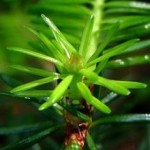 In conclusion, Zymotherapy helps our body organs by making them stronger and healthier. It enhances our immune system while it helps the body to cure a disease automatically. It protects our body without attacking each disease. It helps our body circulation so that our body can reach a balance among all the organs. Zymotherapy acts as the “key” to send nutrition from the stomach to all organs. It helps our body to balance so that our body can be recovered by natural healing power. When we digest well, our body becomes healthy and strong. Ultimately, it drives away diseases. This is the logic of Zymotherapy. Though it seems vague and unspecific, many patients who had no choice but to give up in Western medical science experienced recovery. They regret for wasting their time to find many hospitals. Now they are very glad to know Zymotherapy.
In conclusion, Zymotherapy helps our body organs by making them stronger and healthier. It enhances our immune system while it helps the body to cure a disease automatically. It protects our body without attacking each disease. It helps our body circulation so that our body can reach a balance among all the organs. Zymotherapy acts as the “key” to send nutrition from the stomach to all organs. It helps our body to balance so that our body can be recovered by natural healing power. When we digest well, our body becomes healthy and strong. Ultimately, it drives away diseases. This is the logic of Zymotherapy. Though it seems vague and unspecific, many patients who had no choice but to give up in Western medical science experienced recovery. They regret for wasting their time to find many hospitals. Now they are very glad to know Zymotherapy.
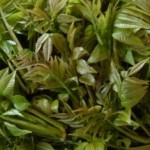 Zymotherapy remedies have a wide range of applications and can benefit people of all ages. Extensive research and clinical experimentation has been carried out to identify the properties of different buds and determine their main indications. Research studies have tested and compared each of the different species within the genus to determine which one has the highest pharmacological effect. For example, that’s why Tilia Tomentosa is used and not one of the other linden trees. Chemical analysis has also focused on assessing the High Performance Liquid Chromatography (HPLC) properties of the buds, young shoots, rootlets and comparing them to the adult plant.
Zymotherapy remedies have a wide range of applications and can benefit people of all ages. Extensive research and clinical experimentation has been carried out to identify the properties of different buds and determine their main indications. Research studies have tested and compared each of the different species within the genus to determine which one has the highest pharmacological effect. For example, that’s why Tilia Tomentosa is used and not one of the other linden trees. Chemical analysis has also focused on assessing the High Performance Liquid Chromatography (HPLC) properties of the buds, young shoots, rootlets and comparing them to the adult plant.
Zymotherapy is a mysterious way to cure cancer, metabolic disorders, immune system disorders and detox-drainage system problems that cannot be explained by modern medicine. It is the best gift from God as people can cure incurable diseases without medicine.
The quality and effectiveness of HerbalZym products are ensured thanks to meticulous selection of the plants used, strict controls at all stages of the preparation process and our experience of over 10 years in Zymotherapy. Our zymotherapy range of over 70 fermented bud extracts include:
We wish to emphasize that we use only freshly picked buds, stabilized at the time of collection and fermented to ensure that no nucleic acids, natural plant hormons, vitamins and minerals are lost. Moreover, our zymo-remedies are concentrated thus ensuring optimum conservation of all the properties within the bud.
| Code | Latin name | Part Used | English name | ||
| HZ-80 | ABIES ALBA | young shoots | Silver fir | ||
| HZ-31 | ACANTHOPANAX SENTICOSUS | buds | Siberian ginseng | ||
| HZ-60 | ACER CAMPESTRE | buds | Hedge maple | ||
| HZ-32 | ACTINIDIA ARGUTA | buds | Hardy kiwi | ||
| HZ-63 | AESCULUS HIPPOCASTANUM | buds | Horse chetsnut | ||
| HZ-54 | ALNUS GLUTINOSA | buds | European alder | ||
| HZ-87 | ALNUS INCANA | buds | Mountain alder | ||
| HZ-84 | AMPELOPSIS VEITCHII | young shoots | Virginia creeper | ||
| HZ-33 | ARALIA ELATA | buds | Korean angelica | ||
| HZ-02 | Asparagus officinalis | young shoots | Asparagus | ||
| HZ-43 | BETULA SP. alba & verrucosa | buds | Birch | ||
| HZ-88 | BETULA VERRUCOSA | sap | Silver birch | ||
| HZ-89 | BETULA VERRUCOSA | buds | Silver birch | ||
| HZ-90 | BETULA VERRUCOSA | seeds | Silver birch | ||
| HZ-91 | BETULA VERRUCOSA | rootlets | Silver birch | ||
| HZ-92 | BETULA VERRUCOSA | catkins | Silver birch | ||
| HZ-93 | BETULA PUBESCENS | buds | White birch | ||
| HZ-94 | BETULA PUBESCENS | bark | White birch | ||
| HZ-62 | CARPINUS BETULUS | buds | Hornbeam | ||
| HZ-82 | CASTANEA VESCA | buds | Sweet chesnut | ||
| HZ-48 | CEDRUS LIBANI | young shoots | Cedar of Lebanon | ||
| HZ-65 | CERCIS SILIQUASTRUM | buds | Judas tree | ||
| HZ-67 | CITRUS LIMONUM | Bark | Lemon tree | ||
| HZ-52 | CORNUS SANGUINEA | buds | Dogwood | ||
| HZ-59 | CORYLUS AVELANA | buds | Hazel | ||
| HZ-58 | CRATAEGUS OXYACANTHA | buds | Hawthorn | ||
| HZ-64 | EQUISETUM ARVENSE | young shoots | Horsetail | ||
| HZ-41 | FAGUS SYLVATICA | buds | Beech | ||
| HZ-55 | FICUS CARCIA | buds | Fig | ||
| HZ-40 | FRAXINUS EXCELSIOR | buds | Ash | ||
| HZ-34 | GARDENIA JASMINODES | buds | Cape jasmine | ||
| HZ-35 | HOVENIA DULCIS | buds | Japanese raisin | ||
| HZ-61 | ILEX AQUIFOLIUM | young shoots | Holly | ||
| HZ-85 | JUGLANS REGIA | buds | Walnut | ||
| HZ-66 | JUNIPERUS COMMUNIS | young shoots | Juniper | ||
| HZ-36 | KALOPANAX PICTUS NAKAI | buds | Castor Aralia | ||
| HZ-95 | LIGUSTRUM VULGARE | young shoots | Privet | ||
| HZ-50 | MALUS SYLVESTRIS | buds | Crab apple | ||
| HZ-74 | OLEA EUROPAEA | young shoots | Olive | ||
| HZ-72 | PINUS MONTANA | buds | Mountain pine | ||
| HZ-75 | PLATANUS ORIENTALIS | buds | Oriental plane | ||
| HZ-46 | POPULUS NIGRA | buds | Black poplar | ||
| HZ-81 | PRUNUS AMYGDALUS | buds | Sweet almond | ||
| HZ-73 | QUERCUS ROBUR | buds | Oak | ||
| HZ-37 | RHUS VERNICIFLUA STOKES | buds | Japanese lacquer tree | ||
| HZ-44 | RIBES NIGRUM | buds | Black currant | ||
| HZ-51 | ROSA CANINA | young shoots | Dog rose | ||
| HZ-77 | ROSMARINUS OFFICINALS | young shoots | Rosemary | ||
| HZ-47 | RUBUS FRUTICOSUS | young shoots | Bramble | ||
| HZ-76 | RUBUS IDAEUS | young shoots | Rasberry | ||
| HZ-45 | SAMBUCUS NIGRA | buds | Black elder | ||
| HZ-38 | SCHIZANDRA CHINESIS | seeds | Five flavor berry | ||
| HZ-78 | SECALE CEREALE | rootlets | Rye | ||
| HZ-56 | SEQUOIA GIGANTEA | young shoots | Giant redwood | ||
| HZ-79 | SORBUS DOMESTICA | buds | Service-tree | ||
| HZ-68 | SYRINGA VULGARIS | buds | Lilac | ||
| HZ-83 | TAMARIX GALLICA | young shoots | Tamarisk | ||
| HZ-69 | TILIA TOMENTOSA | buds | Linden-tree | ||
| HZ-53 | ULMUS CAMPESTRIS | buds | Elm | ||
| HZ-42 | VACCINIUM MYRTILLUS | young shoots | Bilberry | ||
| HZ-49 | VACCINIUM VITIS-IDAEA | young shoots | Cowberry | ||
| HZ-86 | VIBURNUM LANTANA | buds | Wayfaring-tree | ||
| HZ-71 | VISCUM ALBUM | young shoots | Mistletoe | ||
| HZ-57 | VITIS VINIFERA | buds | Grape vine | ||
| HZ-39 | ZANTHOXYLUM SCHINIFOLIUM | buds | Korean sansho | ||
| HZ-70 | ZEA MAYS | rootlets | Maize | ||
| HZ-01 | Ligularia fischeri | young shoots | Gomchi |
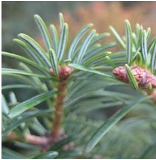 HZ-80, ABIES ALBA or ABIES PECTINATA (Silver fir) constitutes the pediatric remedy par excellence, especially in the disorders of growth and bone tissue metabolism (phospho-calcic). It facilitates the mineral balance and prevents demineralization of the young people thanks to its stimulating action on calcium fixation (it acts efficiently in spasmophilia). Active in joint pains during the growth of teenagers, excellent remineralizing, it relieves painful backs, osteomyelitis, osteochondritis, vertebral epiphysitis. It consolidates fractures, for which it facilitates the formation of bone callus. It is indicated for slim, lengthened people of phosphoric type, rachitic children all in length that are not hungry. Great remedy for caries (it is not impossible that its action comes out in the acid base balance). At respiratory level, Silver Fir acts in asthma, allergies and banal angina. At blood level it stimulates erythropoiesis, demonstrating its stimulating action on bone marrow and bone metabolism in general (it constitutes certainly a potential remedy for anemia and leukemia). Silver Fir is a remedy of yang nature related to the element spleen and metal in Chinese medicine. It is a good stimulant of immunity because it works in benign infections.
HZ-80, ABIES ALBA or ABIES PECTINATA (Silver fir) constitutes the pediatric remedy par excellence, especially in the disorders of growth and bone tissue metabolism (phospho-calcic). It facilitates the mineral balance and prevents demineralization of the young people thanks to its stimulating action on calcium fixation (it acts efficiently in spasmophilia). Active in joint pains during the growth of teenagers, excellent remineralizing, it relieves painful backs, osteomyelitis, osteochondritis, vertebral epiphysitis. It consolidates fractures, for which it facilitates the formation of bone callus. It is indicated for slim, lengthened people of phosphoric type, rachitic children all in length that are not hungry. Great remedy for caries (it is not impossible that its action comes out in the acid base balance). At respiratory level, Silver Fir acts in asthma, allergies and banal angina. At blood level it stimulates erythropoiesis, demonstrating its stimulating action on bone marrow and bone metabolism in general (it constitutes certainly a potential remedy for anemia and leukemia). Silver Fir is a remedy of yang nature related to the element spleen and metal in Chinese medicine. It is a good stimulant of immunity because it works in benign infections.
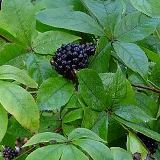 HZ-31, ACANTHOPANAX SENTICOSUS (Siberian ginseng): Siberian ginseng products that are sold in America have nothing in similar with any kind of ginseng. Its anti-fatigue effect is stronger than that of ginseng. Improves function of megalocytes. Improves antigen. Inhibits the growth of cancer cells and leukemia of laboratory mice. Increases the rate of the formation of e-rosette of laboratory mice. The extracts from the plant, taken orally, increased the ability to handle adverse physical conditions, improved mental performance, and enhanced the quality of work under stressful conditions. To avoid adjustment to the herb, it should be used for no longer than 60 consecutive days, followed by a period of 2-3 weeks of abstinence before using it again. The research showed that it improves the oxygen intake up to 8.2% on 20 athletes after taking 400mg per day for 4 weeks. Dilates coronary arteries. Do not use in cases of Arterial hypertension. May not suitable for yin deficient type of bodies.
HZ-31, ACANTHOPANAX SENTICOSUS (Siberian ginseng): Siberian ginseng products that are sold in America have nothing in similar with any kind of ginseng. Its anti-fatigue effect is stronger than that of ginseng. Improves function of megalocytes. Improves antigen. Inhibits the growth of cancer cells and leukemia of laboratory mice. Increases the rate of the formation of e-rosette of laboratory mice. The extracts from the plant, taken orally, increased the ability to handle adverse physical conditions, improved mental performance, and enhanced the quality of work under stressful conditions. To avoid adjustment to the herb, it should be used for no longer than 60 consecutive days, followed by a period of 2-3 weeks of abstinence before using it again. The research showed that it improves the oxygen intake up to 8.2% on 20 athletes after taking 400mg per day for 4 weeks. Dilates coronary arteries. Do not use in cases of Arterial hypertension. May not suitable for yin deficient type of bodies.
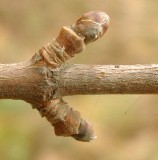 HZ-60, ACER CAMPESTRE (Hedge maple): Like its hard wood, Hedge maple fights against similar phenomena of hardening in the body. It combats cholesterol saturation of bile, which slows down the precipitation of biliary sludge in the form of crystals and micro-gallstones. It is also active in gallbladder lithiasis. The Hedge maple reduces the cholesterol level and is a remedy for atherosclerosis. It has an action in thrombophilic states and a hypoglycemic working which makes it thus useful in fat diabetes. It is also active in cephalgias and dizziness resulting from anxiety neurosis. It is an antifungal and an antiviral.
HZ-60, ACER CAMPESTRE (Hedge maple): Like its hard wood, Hedge maple fights against similar phenomena of hardening in the body. It combats cholesterol saturation of bile, which slows down the precipitation of biliary sludge in the form of crystals and micro-gallstones. It is also active in gallbladder lithiasis. The Hedge maple reduces the cholesterol level and is a remedy for atherosclerosis. It has an action in thrombophilic states and a hypoglycemic working which makes it thus useful in fat diabetes. It is also active in cephalgias and dizziness resulting from anxiety neurosis. It is an antifungal and an antiviral.
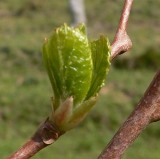 HZ-32, ACTINIDIA ARGUTA (Hardy kiwi): Hardy kiwi is a cousin of the brown fuzzy kiwi seen in most supermarkets today. Athough the kiwi fruit, once referred to as the “Chinese gooseberry,” has been grown and collected from the wild for centuries in Asia, it only recently has become commonly available in the Western world. A cousin of this kiwi, though, the hardy kiwi (Actinidia arguta, Actinidia kolomikta), is much more cold hardy than the plant of the commercially available fruit. It has been used as materials of Chinese medicine named as ‘mihudo’, to treat liver disease, gastrointestinal disease and urogenital lithiasis without toxicity. It reduced blood DHT(dihydrotestosterone) level, promoted the formation of hair root in mouse model experiment, and inhibited the failing out of hair and improved seborrheic skin disease of volunteers such as keratigenous skin, seborrhea etc.
HZ-32, ACTINIDIA ARGUTA (Hardy kiwi): Hardy kiwi is a cousin of the brown fuzzy kiwi seen in most supermarkets today. Athough the kiwi fruit, once referred to as the “Chinese gooseberry,” has been grown and collected from the wild for centuries in Asia, it only recently has become commonly available in the Western world. A cousin of this kiwi, though, the hardy kiwi (Actinidia arguta, Actinidia kolomikta), is much more cold hardy than the plant of the commercially available fruit. It has been used as materials of Chinese medicine named as ‘mihudo’, to treat liver disease, gastrointestinal disease and urogenital lithiasis without toxicity. It reduced blood DHT(dihydrotestosterone) level, promoted the formation of hair root in mouse model experiment, and inhibited the failing out of hair and improved seborrheic skin disease of volunteers such as keratigenous skin, seborrhea etc.
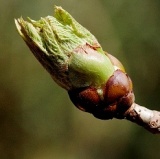 HZ-63, AESCULUS HIPPOCASTANUM (Horse chestnut): Horse Chestnut is mainly a venous circulatory. It cures teleangiectasis, blotched face and periulcerous erythema. As such it is one of the remedies of varicose ulcer. It is especially recommended in hemorrhoids, in particular those with red blood haemorrhages and also at the time of acute haemorrhoidal thrombosis. As venous anti-congestive, it is a great remedy for varices. The bud of chestnut has a perfect digestive tolerance. It facilitates breathing and is indicated in emphysema.
HZ-63, AESCULUS HIPPOCASTANUM (Horse chestnut): Horse Chestnut is mainly a venous circulatory. It cures teleangiectasis, blotched face and periulcerous erythema. As such it is one of the remedies of varicose ulcer. It is especially recommended in hemorrhoids, in particular those with red blood haemorrhages and also at the time of acute haemorrhoidal thrombosis. As venous anti-congestive, it is a great remedy for varices. The bud of chestnut has a perfect digestive tolerance. It facilitates breathing and is indicated in emphysema.
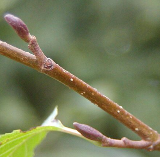 HZ-54, ALNUS GLUTINOSA (European alder): As great circulatory remedy the European Alder acts preventively against thrombosis, as well venous as retinal. It makes too thick blood more fluent by decreasing its viscosity. Its action is remarkable in all vascular spasms, especially after an infarction, in its resolution phase. The alder is a remedy for coronaritis, arteritis, erysipelas and phlebitis for which it acts as an anti-inflammatory. Because of its properties, the alder can advantageously replace the sintrom but only under medical control and with follow-up of the blood parameters. Its remarkable action at the circulatory level makes it possible to understand better the properties of the European alder in as well acute as chronic migraines (with origin often at digestive or circulatory level) and also in fatigues and failures of cerebral circulation common among people whose brain is old or senile, and subject to lapses of memory. A cure of alder allows increasing the intellectual performances and stimulates the attention. At respiratory level the Alder acts very efficiently on the suppurative and inflammatory phase thus avoiding or eliminating antibiotics. It is indicated in all ENT sphere and more particularly in bronchitis, sinusitis, rhinitis, tracheitis and even pleuropneumonia (we believe it may also be active in the otitis). It is the bud to take at the beginning of influenza, tracheitis and sinusitis. At digestive level the Alder is considered as drainer of the stomach, very effective in gastritis, recurrent ulcers and various inflammatory symptoms such as colitis, the peritonitis, cholecystitis. At osteo-articular level the Alder acts in acute articular rheuma, osteoporosis, osteitis and osteomyelitis. It is effective in subacute inflammations with diffusing tendency. It is recommended in Paget’s disease. Finally, its action also appears in chronic urticarias and those of allergic origin (probably thanks to its circulatory and respiratory tropism, skin constituting a secondary emunctory). Thanks to its anti-inflammatory activity, the European Alder is indicated, at renal level, in cystitis and pyelitis.
HZ-54, ALNUS GLUTINOSA (European alder): As great circulatory remedy the European Alder acts preventively against thrombosis, as well venous as retinal. It makes too thick blood more fluent by decreasing its viscosity. Its action is remarkable in all vascular spasms, especially after an infarction, in its resolution phase. The alder is a remedy for coronaritis, arteritis, erysipelas and phlebitis for which it acts as an anti-inflammatory. Because of its properties, the alder can advantageously replace the sintrom but only under medical control and with follow-up of the blood parameters. Its remarkable action at the circulatory level makes it possible to understand better the properties of the European alder in as well acute as chronic migraines (with origin often at digestive or circulatory level) and also in fatigues and failures of cerebral circulation common among people whose brain is old or senile, and subject to lapses of memory. A cure of alder allows increasing the intellectual performances and stimulates the attention. At respiratory level the Alder acts very efficiently on the suppurative and inflammatory phase thus avoiding or eliminating antibiotics. It is indicated in all ENT sphere and more particularly in bronchitis, sinusitis, rhinitis, tracheitis and even pleuropneumonia (we believe it may also be active in the otitis). It is the bud to take at the beginning of influenza, tracheitis and sinusitis. At digestive level the Alder is considered as drainer of the stomach, very effective in gastritis, recurrent ulcers and various inflammatory symptoms such as colitis, the peritonitis, cholecystitis. At osteo-articular level the Alder acts in acute articular rheuma, osteoporosis, osteitis and osteomyelitis. It is effective in subacute inflammations with diffusing tendency. It is recommended in Paget’s disease. Finally, its action also appears in chronic urticarias and those of allergic origin (probably thanks to its circulatory and respiratory tropism, skin constituting a secondary emunctory). Thanks to its anti-inflammatory activity, the European Alder is indicated, at renal level, in cystitis and pyelitis.
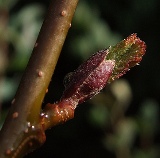 HZ-87, ALNUS INCANA (Mountain alder): Mountain alder’s action on inflammatory conditions is stronger than that of European alder (Alnus Glutinosa). Mountain alder is for those patients whose inflammatory conditions do not predispose them to any one terrain. Mountain alder is the first remedy to give after a myocardial infarction in order to prevent further damage to heart.
HZ-87, ALNUS INCANA (Mountain alder): Mountain alder’s action on inflammatory conditions is stronger than that of European alder (Alnus Glutinosa). Mountain alder is for those patients whose inflammatory conditions do not predispose them to any one terrain. Mountain alder is the first remedy to give after a myocardial infarction in order to prevent further damage to heart.
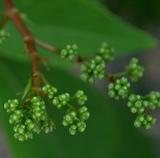 HZ-84, AMPELOPSIS VEITCHII (Virginia creeper): Virginia creeper constitutes a great remedy for deforming inflammatory arthritis (rheumatoid polyarthritis, inflammatory rheumatism), large deformations of evolutive chronic polyarthritis and especially pains and deformations of the small joints. It is particularly indicated when tendons and ligaments are involved. Virginia creeper acts efficiently in sclerotic retraction and is indicated in various diseases (Dupuytren, Peyronie, Bouchart nodule, Heberden nodule). Of Yin nature, antisclerotic, it is also indicated in local fibrous indurations, especially in inflammatory after-effects, in particular post-inflammatory adhesions.
HZ-84, AMPELOPSIS VEITCHII (Virginia creeper): Virginia creeper constitutes a great remedy for deforming inflammatory arthritis (rheumatoid polyarthritis, inflammatory rheumatism), large deformations of evolutive chronic polyarthritis and especially pains and deformations of the small joints. It is particularly indicated when tendons and ligaments are involved. Virginia creeper acts efficiently in sclerotic retraction and is indicated in various diseases (Dupuytren, Peyronie, Bouchart nodule, Heberden nodule). Of Yin nature, antisclerotic, it is also indicated in local fibrous indurations, especially in inflammatory after-effects, in particular post-inflammatory adhesions.
HZ-33, ARALIA ELATA (Korean angelica, Japanese angelica): The roots and stems are anodyne and carminative. All parts of the plant are used for the treatment of rheumatoid arthralgia, coughs, diabetes, jaundice, stomach ulcers and stomach cancers. Young shoots – cooked. They can also be blanched and used in salads.
 HZ-02, ASPARAGUS OFFICINALIS (Asparagus): Asparagus is one of nature’s most perfect foods. Asparagus are poor in calories and loaded with vitamins and minerals. Asparagus also contains the phyto-chemical glutathione, which has antioxidant and anticarcinogenic properties. According to the National Cancer Institute, asparagus is the highest tested food containing glutathione, one of the body’s most potent cancer fighters. Additionally, asparagus is high in rutin, which is valuable in strengthening the blood vessels. Glutathione is a small protein composed of three amino acids; cysteine, glutamic acid, and glycine. Glutathione is involved in detoxification. It binds to fat-soluble toxins, such as heavy metals, solvents, and pesticides, and transforms them into a water-soluble form that can be excreted in urine. Researchers in India tested extracts from the plants on microbes taken from the mouths of oral cancer patients. Eight had a significant impact on the growth of the organisms in the laboratory. Natural antibiotics in asparagus can fight infections. Among the most effective bug-busting plants were asparagus, desert date, false daisy, caster oil, and fenugreek. Asparagus also has proven to be helpful in curing cancer of different kinds like Hodgkin’s lymphoma, previously known as Hodgkin’s disease, which is a cancer originating from white blood cells called lymphocytes, bladder cancer, lung cancer and skin cancer.
HZ-02, ASPARAGUS OFFICINALIS (Asparagus): Asparagus is one of nature’s most perfect foods. Asparagus are poor in calories and loaded with vitamins and minerals. Asparagus also contains the phyto-chemical glutathione, which has antioxidant and anticarcinogenic properties. According to the National Cancer Institute, asparagus is the highest tested food containing glutathione, one of the body’s most potent cancer fighters. Additionally, asparagus is high in rutin, which is valuable in strengthening the blood vessels. Glutathione is a small protein composed of three amino acids; cysteine, glutamic acid, and glycine. Glutathione is involved in detoxification. It binds to fat-soluble toxins, such as heavy metals, solvents, and pesticides, and transforms them into a water-soluble form that can be excreted in urine. Researchers in India tested extracts from the plants on microbes taken from the mouths of oral cancer patients. Eight had a significant impact on the growth of the organisms in the laboratory. Natural antibiotics in asparagus can fight infections. Among the most effective bug-busting plants were asparagus, desert date, false daisy, caster oil, and fenugreek. Asparagus also has proven to be helpful in curing cancer of different kinds like Hodgkin’s lymphoma, previously known as Hodgkin’s disease, which is a cancer originating from white blood cells called lymphocytes, bladder cancer, lung cancer and skin cancer.
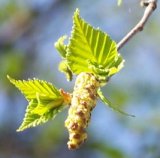 HZ-43, BETULA SP. alba & verrucosa (Birch): It is a valuable remedy in rheumatic diseases, in the remainders of gout, in a crowd of chronic evils against which medical science is so exposed to fail. The sap, also known as “birch water ” is exclusively collected in spring, just when the body, coming out of the winter, needs cleansing itself of all the then accumulated wastes. It is spring which will make inflate the birch buds which contain many active ingredients (essential oils, tannins, flavonic derivatives, sesquiterpenes and vitamin C).
HZ-43, BETULA SP. alba & verrucosa (Birch): It is a valuable remedy in rheumatic diseases, in the remainders of gout, in a crowd of chronic evils against which medical science is so exposed to fail. The sap, also known as “birch water ” is exclusively collected in spring, just when the body, coming out of the winter, needs cleansing itself of all the then accumulated wastes. It is spring which will make inflate the birch buds which contain many active ingredients (essential oils, tannins, flavonic derivatives, sesquiterpenes and vitamin C).
The buds and the sap activate the diuresis and the elimination of organic wastes such as uric acid and cholesterol. The birch bud is successfully used by people suffering from water retention (causing edema, obesity …), rheumatic diseases, osteoarthritis and gout, cellulitis, kidney and bladder lithiasis, certain skin diseases, often caused by defective functioning of the excretory system. Birch is a general drainer for the liver (anti-toxic) and the urinary tracts (nephritis, kidney stones). It is particularly active in osteoporosis, arthritis and chronic polyarthritis. Of Yang nature, it is a tonicum useful in rickets, disorders of growth, general tiredness.
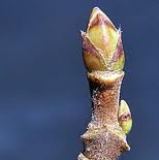 HZ-89, BETULA VERRUCOSA (Silver birch): An infusion made with silver birch leaves hastens the removal of waste products in the urine and is beneficial for kidney stones and bladder stones (gravel), rheumatic conditions and gout. The leaves are also used, in combination with diuretic herbs, to reduce fluid retention and swelling. Silver birch sap is a mild diuretic. The oil distilled from the leaves is antiseptic and is commonly used in preparations to treat eczema and psoriasis. A decoction of silver birch bark can be used as a lotion for chronic skin problems. The bark can also be macerated in oil and applied to joints for the relief of rheumatism.
HZ-89, BETULA VERRUCOSA (Silver birch): An infusion made with silver birch leaves hastens the removal of waste products in the urine and is beneficial for kidney stones and bladder stones (gravel), rheumatic conditions and gout. The leaves are also used, in combination with diuretic herbs, to reduce fluid retention and swelling. Silver birch sap is a mild diuretic. The oil distilled from the leaves is antiseptic and is commonly used in preparations to treat eczema and psoriasis. A decoction of silver birch bark can be used as a lotion for chronic skin problems. The bark can also be macerated in oil and applied to joints for the relief of rheumatism.
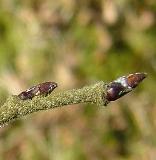 HZ-93, BETULA PUBESCENS (White birch): Recent research suggests that the betulic acid, which makes birch tree’s bark white, may be effective in the treatment of skin cancer. The leaf tea is said to stimulate urination. The leaves, twigs and buds contain salycaltes, so they have been used to make medical teas which help cure pain and inflammation.
HZ-93, BETULA PUBESCENS (White birch): Recent research suggests that the betulic acid, which makes birch tree’s bark white, may be effective in the treatment of skin cancer. The leaf tea is said to stimulate urination. The leaves, twigs and buds contain salycaltes, so they have been used to make medical teas which help cure pain and inflammation.
.
.
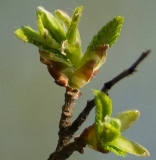 HZ-62, CARPINUS BETULUS (Hornbeam): Hornbeam is a great remedy for platelet deficiency (thrombocytopenia). It normalizes the bleeding time, increases the number of platelets and their cytologic quality (agglutination). This thrombocytopenia may be acquired by splenectomy, by autoimmune reaction or by immuno-allergy. Thrombopathies are mainly post-medicamentous, more particularly poisoning by anticoagulants. Hornbeam is an antihaemorrhagic useful in purpuras and haemorrhages due to anticoagulants (then associated with dogwood). It eliminates cholesterol and works in atherosclerosis. It is recommended in hepatic insufficiencies, uremia and uricemia. At the respiratory level, it acts as an antispasmodic and presents a specific action on the sinus mucousa. Hornbeam constitutes an excellent remedy of the sinusitis, spasmodic rhinitis and chronic bronchitis.
HZ-62, CARPINUS BETULUS (Hornbeam): Hornbeam is a great remedy for platelet deficiency (thrombocytopenia). It normalizes the bleeding time, increases the number of platelets and their cytologic quality (agglutination). This thrombocytopenia may be acquired by splenectomy, by autoimmune reaction or by immuno-allergy. Thrombopathies are mainly post-medicamentous, more particularly poisoning by anticoagulants. Hornbeam is an antihaemorrhagic useful in purpuras and haemorrhages due to anticoagulants (then associated with dogwood). It eliminates cholesterol and works in atherosclerosis. It is recommended in hepatic insufficiencies, uremia and uricemia. At the respiratory level, it acts as an antispasmodic and presents a specific action on the sinus mucousa. Hornbeam constitutes an excellent remedy of the sinusitis, spasmodic rhinitis and chronic bronchitis.
At articular level, Hornbeam acts in post-medicamentous periarthritis nodosa and in progressive chronic polyarthritis.
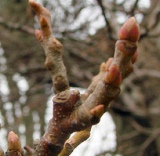 HZ-82, CASTANEA VESCA (Sweet chesnut): Food tree above all, with multiple uses, the chestnut is used not only for its buds but also, and chiefly, for its seeds, often confused with horse-chestnuts. Other parts of the tree are used, such as the leaves (fodder, baths and expectorants), kittens (anti-diarrheal), bark (astringent), honey (cough, lungs), wood (parquet floor, framework, barrel, furniture, stakes and various utensils), flower (floral elixir of Dr. Bach) and the fruit shell (paint). Zymotherapy uses the chestnut bud principally at the level of the circulatory system, as well venous as lymphatic. Great drainer of the venous system, the bud of chestnut is indicated in congestive phenomena, such as varixes and circulatory stases in general. It is a remedy of varicose ulcers, which it reabsorbs while eliminating the periulcerous erythema. The chestnut fights against auto-intoxication of the body and spasmodic phenomena. Thanks to its action on the lymphatic system, the chestnut acts in-depth on oedemas (which do not always depend on the kidney), cellulitis, the feeling of heaviness.
HZ-82, CASTANEA VESCA (Sweet chesnut): Food tree above all, with multiple uses, the chestnut is used not only for its buds but also, and chiefly, for its seeds, often confused with horse-chestnuts. Other parts of the tree are used, such as the leaves (fodder, baths and expectorants), kittens (anti-diarrheal), bark (astringent), honey (cough, lungs), wood (parquet floor, framework, barrel, furniture, stakes and various utensils), flower (floral elixir of Dr. Bach) and the fruit shell (paint). Zymotherapy uses the chestnut bud principally at the level of the circulatory system, as well venous as lymphatic. Great drainer of the venous system, the bud of chestnut is indicated in congestive phenomena, such as varixes and circulatory stases in general. It is a remedy of varicose ulcers, which it reabsorbs while eliminating the periulcerous erythema. The chestnut fights against auto-intoxication of the body and spasmodic phenomena. Thanks to its action on the lymphatic system, the chestnut acts in-depth on oedemas (which do not always depend on the kidney), cellulitis, the feeling of heaviness.
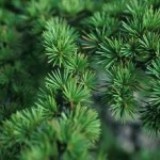 HZ-48, CEDRUS LIBANI (Cedar of Lebanon): The Cedar of Lebanon is principally a draining remedy of the cutaneous system. It is, by the way, a plant which enters in good number of cosmetic preparations. It works particularly in dry eczema, chronic dermatitis, psoriasis, keratotic eczema, lichenified dermatosis. It is a remedy of the elderly whose skin, badly vascularised, dries or develops a senile prurit. The skin constitutes one of the emonctories to be put in function when kidneys and liver become insufficient. It is interesting to notice that the cedar is also indicated in irritations of the digestive and respiratory mucosa. These two functions, in relation to the skin, are just connected to the same element (metal) of Chinese medicine which regulates lung and large intestine. It seems then logical to see Cedar of Lebanon used for syndromes of chronic poisoning and allergic events. Taken for long enough, it is acting deeply to eliminate toxins from the body.
HZ-48, CEDRUS LIBANI (Cedar of Lebanon): The Cedar of Lebanon is principally a draining remedy of the cutaneous system. It is, by the way, a plant which enters in good number of cosmetic preparations. It works particularly in dry eczema, chronic dermatitis, psoriasis, keratotic eczema, lichenified dermatosis. It is a remedy of the elderly whose skin, badly vascularised, dries or develops a senile prurit. The skin constitutes one of the emonctories to be put in function when kidneys and liver become insufficient. It is interesting to notice that the cedar is also indicated in irritations of the digestive and respiratory mucosa. These two functions, in relation to the skin, are just connected to the same element (metal) of Chinese medicine which regulates lung and large intestine. It seems then logical to see Cedar of Lebanon used for syndromes of chronic poisoning and allergic events. Taken for long enough, it is acting deeply to eliminate toxins from the body.
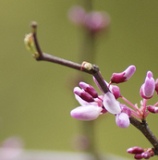 HZ-65, CERCIS SILIQUASTRUM (Judas tree): The Judas tree is a circulatory remedy.
HZ-65, CERCIS SILIQUASTRUM (Judas tree): The Judas tree is a circulatory remedy.
This bud works particularly as anti-thrombophilic in retinal thrombosis but also in juvenile arteritis (Buerger’s disease) and arteritis of the ends. So it acts on cerebral, hepatic and renal atherosclerosis.
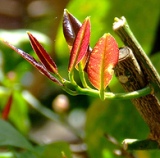 HZ-67, CITRUS LIMONUM (Lemon tree): Lemon-tree bark acts as blood thinner particularly at the venous level, in varixes. It relieves arteritis of lower limbs and is indicated in infarction. It calms palpitations. Remedy for decompensated cirrhosis, cardiac cirrhosis, gout affections and dyslipemic disorders. Lemon-tree bark helps people with migraine, particularly headaches of nervous origin. It also intervenes in epileptic syndromes, neurasthenia and insomnia. At digestion level it combats digestive atony. Moreover it quiets effectively hiccups and relieves spasmodic coughs and painful twitching. Lemon tree constitutes a good remedy complementary to other Zymotherapy remedies.
HZ-67, CITRUS LIMONUM (Lemon tree): Lemon-tree bark acts as blood thinner particularly at the venous level, in varixes. It relieves arteritis of lower limbs and is indicated in infarction. It calms palpitations. Remedy for decompensated cirrhosis, cardiac cirrhosis, gout affections and dyslipemic disorders. Lemon-tree bark helps people with migraine, particularly headaches of nervous origin. It also intervenes in epileptic syndromes, neurasthenia and insomnia. At digestion level it combats digestive atony. Moreover it quiets effectively hiccups and relieves spasmodic coughs and painful twitching. Lemon tree constitutes a good remedy complementary to other Zymotherapy remedies.
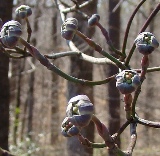 HZ-52, CORNUS SANGUINEA (Dogwood): Dogwood constitutes a major remedy of the heart, as well on the level of coronary insufficiency and coronaritis as on that of senile heart, but especially as preventive for infarction. It neutralizes the formation of infarction. At arterial level Dogwood acts as drainer of arteries and anti-inflammatory. It is indicated in various arteritis, particularly those of lower limbs and those of nicotinic (any smoker should regularly make a cure of dogwood), and those of Horton (inflammation of the temporal artery). Its tonic action on arteries is associated with anti-atherosclerosis properties. It is a great anti-thrombotic remedy. Its anticoagulant action which contributes to maintain blood fluidity is paradoxically associated with anti-hemorrhagic properties, as well at cranial, as at abdominal and thoracic level. Certain plants are thus bipolar according to the action to perform. By its circulatory action, dogwood acts as antinecrotic on tissues, even in acute phase, when this necrosis comes from an infarction of capillaries. Its action on oedemas makes it perhaps possible to understand that it is also active on the spleen. It is a fact that Dogwood strangely acts as stimulator of bone marrow (stimulation of mast cells and plasma cells). At renal level, Dogwood is active in nephrosis (bad working of renal glomerulus whose blood capillaries no longer retain proteins of blood) the origin of which is unknown in medicine, could be at the level of the spleen functioning according to Chinese traditional medicine. At glandular level, Dogwood is indicated in hyperthyroidism (Basedow’s disease), the appearance of euthyroidic goitre and the phenomena of dysendocrinia. Let us also mention that the Kupffer cells of the liver are stimulated by Dogwood.
HZ-52, CORNUS SANGUINEA (Dogwood): Dogwood constitutes a major remedy of the heart, as well on the level of coronary insufficiency and coronaritis as on that of senile heart, but especially as preventive for infarction. It neutralizes the formation of infarction. At arterial level Dogwood acts as drainer of arteries and anti-inflammatory. It is indicated in various arteritis, particularly those of lower limbs and those of nicotinic (any smoker should regularly make a cure of dogwood), and those of Horton (inflammation of the temporal artery). Its tonic action on arteries is associated with anti-atherosclerosis properties. It is a great anti-thrombotic remedy. Its anticoagulant action which contributes to maintain blood fluidity is paradoxically associated with anti-hemorrhagic properties, as well at cranial, as at abdominal and thoracic level. Certain plants are thus bipolar according to the action to perform. By its circulatory action, dogwood acts as antinecrotic on tissues, even in acute phase, when this necrosis comes from an infarction of capillaries. Its action on oedemas makes it perhaps possible to understand that it is also active on the spleen. It is a fact that Dogwood strangely acts as stimulator of bone marrow (stimulation of mast cells and plasma cells). At renal level, Dogwood is active in nephrosis (bad working of renal glomerulus whose blood capillaries no longer retain proteins of blood) the origin of which is unknown in medicine, could be at the level of the spleen functioning according to Chinese traditional medicine. At glandular level, Dogwood is indicated in hyperthyroidism (Basedow’s disease), the appearance of euthyroidic goitre and the phenomena of dysendocrinia. Let us also mention that the Kupffer cells of the liver are stimulated by Dogwood.
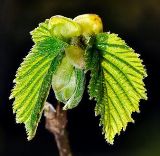 HZ-59, CORYLUS AVELLANA (Hazel): The Hazel bud has an activity on all metabolisms with exception of sugars. It is one of the polyvalent remedies in Zymotherapy. At pulmonary level the Hazel bud acts as drainer of the lungs, more particularly in cardiopulmonary cases with fibro-sclerotic profile. It is indicated in pulmonary stases and sclerosis, bronchitis, emphysema and asthma with emphysema. At circulatory level it is active in hypochromic anemia with cirrhotic or digestive origin (intestinal bleedings). Hazelnut oil is also anti-anemic. Moreover it facilitates the synthesis of red blood cells (erythropoiesis) in marrow. Hazel is active in circulatory stases which lead to the appearance of varicous ulcers. Overall hypocoagulant, it is effective in thrombosis, reduces cholesterol, acts in nercrosis of the extremities which can lead to senile gangrene. It is also a remedy for arteritis, especially that of the lower limbs or those which lead to gangrene. It acts also on hypotonic sclerotic people At hepatic level Hazel constitutes with juniper one of the greatest remedies of cirrhosis, as well bronze cirrhosis, as of Hanot or alcoholic cirrhosis(non ascitic). Its action also appears in hepatic steatosis (fatty liver). At nervous level Hazel acts as nervous rebalancer, useful in depressions, neuro-vegetative imbalances, dyspepsia. It is also efficient in headache likely with hepatic or circulatory origin – n.o.a. Its action at renal level appears in the resorption of oedemas of the lower extremities (and seems to show a polarity with the spleen of the traditional Chinese medicine).
HZ-59, CORYLUS AVELLANA (Hazel): The Hazel bud has an activity on all metabolisms with exception of sugars. It is one of the polyvalent remedies in Zymotherapy. At pulmonary level the Hazel bud acts as drainer of the lungs, more particularly in cardiopulmonary cases with fibro-sclerotic profile. It is indicated in pulmonary stases and sclerosis, bronchitis, emphysema and asthma with emphysema. At circulatory level it is active in hypochromic anemia with cirrhotic or digestive origin (intestinal bleedings). Hazelnut oil is also anti-anemic. Moreover it facilitates the synthesis of red blood cells (erythropoiesis) in marrow. Hazel is active in circulatory stases which lead to the appearance of varicous ulcers. Overall hypocoagulant, it is effective in thrombosis, reduces cholesterol, acts in nercrosis of the extremities which can lead to senile gangrene. It is also a remedy for arteritis, especially that of the lower limbs or those which lead to gangrene. It acts also on hypotonic sclerotic people At hepatic level Hazel constitutes with juniper one of the greatest remedies of cirrhosis, as well bronze cirrhosis, as of Hanot or alcoholic cirrhosis(non ascitic). Its action also appears in hepatic steatosis (fatty liver). At nervous level Hazel acts as nervous rebalancer, useful in depressions, neuro-vegetative imbalances, dyspepsia. It is also efficient in headache likely with hepatic or circulatory origin – n.o.a. Its action at renal level appears in the resorption of oedemas of the lower extremities (and seems to show a polarity with the spleen of the traditional Chinese medicine).
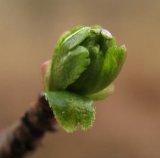 HZ-58, CRATAEGUS OXYACANTHA (Hawthorn): Traditionally used for heart problems, the Hawthorn bud serves as a perfect example of how a bud can incorporate all the properties of the whole plant. It possesses both the calming properties of the flowers (cardiac rhythm, tension) and the tonic influence of the fruit on the heart muscle. At circulatory level the Hawthorn bud has an arterial antisclerotic action and works as a heart drainer. Great remedy of the functional arrhythmias (distressing extrasystoles, tachycardias), the hawthorn is ambivalent because it normalises tension whatsoever from a hypo- or a hypertension. The macerate has a positive inotropic and chronotropic action. In the insufficiencies of the myocardium, hawthorn reinforces the contractile force of the heart. It is also indicated in the late effects of infarction, angor pectoris (angina pectoris), tired heart and precordial anxiety (useful as cardiac sedative). At nervous system the hawthorn bud is a sedative of the central nervous system. Therefore it acts as an anxiolytic, having sympathicolytic properties while balancing the vago-sympathetic system. So it plays a role in treatments of existential depression. At hormonal level it is indicated in hyperthyroidism. At digestive level it helps regulate compulsive eating trend leading to overweight. At pulmonary level it calms non-allergic dyspnoea of intrinsic origin. It intervenes in any degenerative disease leading to tissue sclerosis.
HZ-58, CRATAEGUS OXYACANTHA (Hawthorn): Traditionally used for heart problems, the Hawthorn bud serves as a perfect example of how a bud can incorporate all the properties of the whole plant. It possesses both the calming properties of the flowers (cardiac rhythm, tension) and the tonic influence of the fruit on the heart muscle. At circulatory level the Hawthorn bud has an arterial antisclerotic action and works as a heart drainer. Great remedy of the functional arrhythmias (distressing extrasystoles, tachycardias), the hawthorn is ambivalent because it normalises tension whatsoever from a hypo- or a hypertension. The macerate has a positive inotropic and chronotropic action. In the insufficiencies of the myocardium, hawthorn reinforces the contractile force of the heart. It is also indicated in the late effects of infarction, angor pectoris (angina pectoris), tired heart and precordial anxiety (useful as cardiac sedative). At nervous system the hawthorn bud is a sedative of the central nervous system. Therefore it acts as an anxiolytic, having sympathicolytic properties while balancing the vago-sympathetic system. So it plays a role in treatments of existential depression. At hormonal level it is indicated in hyperthyroidism. At digestive level it helps regulate compulsive eating trend leading to overweight. At pulmonary level it calms non-allergic dyspnoea of intrinsic origin. It intervenes in any degenerative disease leading to tissue sclerosis.
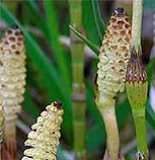 HZ-64, EQUISETUM ARVENSE (Horsetail): Young shoots of Horsetail have a remineralizing action at osteo-articular level which helps to repair fractures and also to combat rheumatisms. Moreover they have a diuretic power and fight against cystitis. At blood system level Horsetail is an anti-hemorrhoidal and anti-hemorrhagic remedy.
HZ-64, EQUISETUM ARVENSE (Horsetail): Young shoots of Horsetail have a remineralizing action at osteo-articular level which helps to repair fractures and also to combat rheumatisms. Moreover they have a diuretic power and fight against cystitis. At blood system level Horsetail is an anti-hemorrhoidal and anti-hemorrhagic remedy.
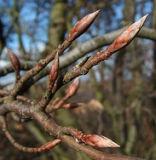 HZ-41, FAGUS SYLVATICA (Beech): Beech flowers are used to treat intolerance. Beech leaves were used by American Indian tribes to treat frostbite and burned or scalded skin. The infusion was also used to treat diaper rash, poison ivy, poison oak, and the inflammation that accompanies them. Beech may be applied to swellings and scabs for healing purposes.
HZ-41, FAGUS SYLVATICA (Beech): Beech flowers are used to treat intolerance. Beech leaves were used by American Indian tribes to treat frostbite and burned or scalded skin. The infusion was also used to treat diaper rash, poison ivy, poison oak, and the inflammation that accompanies them. Beech may be applied to swellings and scabs for healing purposes.
.
.
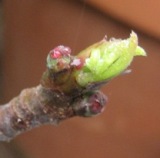 HZ-55, FICUS CARCIA (Fig tree): The Fig tree bud is an extraordinary remedy (the Fig tree was sacred in antiquity) because it acts in depth on our endocrine system, contributing thus to the regulation of good number of problems. The Fig tree is used as stomach drainer. Powerful remedy for gastric and duodenal ulcer, diaphragmatic hernia, esophageal dysphagia, gastritis and colitis. It also acts effectively in bulimic tendencies, regulates appetite and stomach secretions (hypo – hyperchlorhydria). It is effective in migraines. It is also recommended in iron deficiency anemia, feeling of heavy head. Its calming action is remarkable. It constitutes the opposite pole of blackcurrant. The fig tree sends to sleep, stimulates dreams and calms thoughts. It will be a precious help to reduce problems induced by jet lag when travelling or for persons working on shift. Take fig tree to fall asleep and blackcurrant to get awake. It is an anti-anxiety of first order, useful to neutralize the effects of stress, as well internally as externally. It acts in all nervous disorder (spasmophilia, epilepsy, facial neuralgia, etc.) and will help to ensure healthy, natural sleep. The Fig tree has a characteristic action on the regulating system of our body that are hormones. Active on the brain (cortico-hypothalamic axis), it acts in existential depression, neurosensorial balance, psychosomatic disorders, subjective syndromes, general state. The Fig tree is a typical YIN remedy (whereas blackcurrant of YANG nature is).
HZ-55, FICUS CARCIA (Fig tree): The Fig tree bud is an extraordinary remedy (the Fig tree was sacred in antiquity) because it acts in depth on our endocrine system, contributing thus to the regulation of good number of problems. The Fig tree is used as stomach drainer. Powerful remedy for gastric and duodenal ulcer, diaphragmatic hernia, esophageal dysphagia, gastritis and colitis. It also acts effectively in bulimic tendencies, regulates appetite and stomach secretions (hypo – hyperchlorhydria). It is effective in migraines. It is also recommended in iron deficiency anemia, feeling of heavy head. Its calming action is remarkable. It constitutes the opposite pole of blackcurrant. The fig tree sends to sleep, stimulates dreams and calms thoughts. It will be a precious help to reduce problems induced by jet lag when travelling or for persons working on shift. Take fig tree to fall asleep and blackcurrant to get awake. It is an anti-anxiety of first order, useful to neutralize the effects of stress, as well internally as externally. It acts in all nervous disorder (spasmophilia, epilepsy, facial neuralgia, etc.) and will help to ensure healthy, natural sleep. The Fig tree has a characteristic action on the regulating system of our body that are hormones. Active on the brain (cortico-hypothalamic axis), it acts in existential depression, neurosensorial balance, psychosomatic disorders, subjective syndromes, general state. The Fig tree is a typical YIN remedy (whereas blackcurrant of YANG nature is).
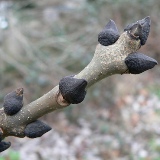 HZ-40, FRAXINUS EXCELSIOR (Ash): The suppleness, flexibility of Ash wood are curiously similar to certain medicinal properties of its bud preparation in Zymotherapy, namely its action on ligaments. The ash has a targeted action on the osteo-articular apparatus and on the renal system. Recommended for overweight it reduces cholesterol and uric acid with a light action on urea. It acts in gout, has an anti-inflammatory action on synovial level and has anti-inflammatory properties on ligaments in general. Comparing the medicinal properties of different parts of the tree with those of the bud we see that the Ash can be considered as a great potential anti-rheumatic remedy, which is not yet currently mentioned in literature. Other interesting properties of the bud are worth checking their presence at bud level. These include: trapping free radicals, depurative, febrifugal and prostate protecting properties.
HZ-40, FRAXINUS EXCELSIOR (Ash): The suppleness, flexibility of Ash wood are curiously similar to certain medicinal properties of its bud preparation in Zymotherapy, namely its action on ligaments. The ash has a targeted action on the osteo-articular apparatus and on the renal system. Recommended for overweight it reduces cholesterol and uric acid with a light action on urea. It acts in gout, has an anti-inflammatory action on synovial level and has anti-inflammatory properties on ligaments in general. Comparing the medicinal properties of different parts of the tree with those of the bud we see that the Ash can be considered as a great potential anti-rheumatic remedy, which is not yet currently mentioned in literature. Other interesting properties of the bud are worth checking their presence at bud level. These include: trapping free radicals, depurative, febrifugal and prostate protecting properties.
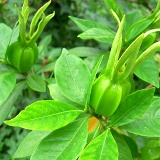 HZ-34, GARDENIA JASMINOIDES (Cape jasmine): Cape jasmine fruit is used within Traditional Chinese Medicine to “drain fire” and thereby treat certain febrile conditions. Cape jasmine fruit is considered cooling in nature, serving to reduce swelling and stop bleeding. It is used to treat fever, irritability, restlessness, a stifling sensation in the chest, insomnia, and rosacea. It also treats urinary tract infections, jaundice, mouth sores, nosebleeds, and blood in vomit, urine, or stool. The herb is charred to strengthen its ability to halt bleeding. Another important use of Cape jasmine fruit is a topical application as a powder mixed with egg white to treat traumatic injuries, sprains, bruises, and to reduce swelling. In one study it significantly lowered serum IL-1β and TNF-α level in rheumatoid arthritis rats, and its effect had a close relation with inhibitory development of rheumatoid arthritis in the rats.
HZ-34, GARDENIA JASMINOIDES (Cape jasmine): Cape jasmine fruit is used within Traditional Chinese Medicine to “drain fire” and thereby treat certain febrile conditions. Cape jasmine fruit is considered cooling in nature, serving to reduce swelling and stop bleeding. It is used to treat fever, irritability, restlessness, a stifling sensation in the chest, insomnia, and rosacea. It also treats urinary tract infections, jaundice, mouth sores, nosebleeds, and blood in vomit, urine, or stool. The herb is charred to strengthen its ability to halt bleeding. Another important use of Cape jasmine fruit is a topical application as a powder mixed with egg white to treat traumatic injuries, sprains, bruises, and to reduce swelling. In one study it significantly lowered serum IL-1β and TNF-α level in rheumatoid arthritis rats, and its effect had a close relation with inhibitory development of rheumatoid arthritis in the rats.
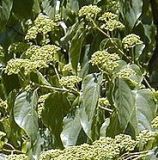 HZ-35, HOVENIA DULCIS (Japanese raisin tree): It has been introduced as an ornamental tree to several countries. The sweet and fragrant fruit is edible raw or cooked. The fruit is antispasmodic, febrifuge, laxative and diuretic. The seeds are diuretic and are used in the treatment of alcohol overdose. The seeds are used to relieve intoxication due to wine. The stem bark is used in the treatment of rectal diseases. An extract of the leave contains hodulcine, a glycoside which exhibits an anti-sweet activity. Ampelopsin is a flavanonol found in Japanese raisin tree and is credited with hepatoprotective effects. The Korea Food & Drug Administration approved on December 2008 that extracts of the Japanese raisin tree fruit can protect and help recover the liver from substances such as alcohol. The main chemical for this effect is Quercetin, which has anti-inflammatory and anti-oxidant properties.
HZ-35, HOVENIA DULCIS (Japanese raisin tree): It has been introduced as an ornamental tree to several countries. The sweet and fragrant fruit is edible raw or cooked. The fruit is antispasmodic, febrifuge, laxative and diuretic. The seeds are diuretic and are used in the treatment of alcohol overdose. The seeds are used to relieve intoxication due to wine. The stem bark is used in the treatment of rectal diseases. An extract of the leave contains hodulcine, a glycoside which exhibits an anti-sweet activity. Ampelopsin is a flavanonol found in Japanese raisin tree and is credited with hepatoprotective effects. The Korea Food & Drug Administration approved on December 2008 that extracts of the Japanese raisin tree fruit can protect and help recover the liver from substances such as alcohol. The main chemical for this effect is Quercetin, which has anti-inflammatory and anti-oxidant properties.
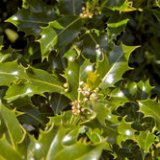 HZ-61, ILEX AQUIFOLIUM (Holly): Holly leaves were used as a diaphoretic and an infusion of them was given in catarrh, bronchitis, pneumonia, influenza, pleurisy and smallpox. They have also been used in intermittent fevers and rheumatism for their tonic properties. The juice of the fresh leaves has been used to advantage in jaundice, and when sniffed was said to stop a runny nose. When soaked in vinegar and left for a day and a night, it was used to cure corns. An old remedy for chilblains was to thrash them with a branch of Holly to “chase the chills out”, but this could also be painful. The berries possess totally different qualities to the leaves, being violently emetic and purgative, and if swallowed can cause excessive vomiting. They have been used in dropsy, and in a powder form as an astringent to check bleeding. Nicholas Culpeper in his “The Complete Herbal” (1653) say’s that: “the bark and leaves are good used as fomentations for broken bones and such members as are out of joint”. He also considered the berries to be curative of colic. Care needs to be taken however, for Holly berries can be poisonous if given to children. The leaves of the Holly were used in the Black Forest as a substitute for tea. In Brazil “Paraguay Tea” is made from the dried leaves and young shoots of another species of Holly called (Ilex Paraguayensis), which grows in South America. Other types used to make tea are (Ilex Gongonha) and (Ilex Theezans), all of which are considered valuable as diuretics and diaphoretics. The leaves of the Ilex Paraguayensis and several others species of Holly contain tannin, which was used as a dye. Acting like galls when bruised in a ferruginous mud, they were mostly used to dye cotton.
HZ-61, ILEX AQUIFOLIUM (Holly): Holly leaves were used as a diaphoretic and an infusion of them was given in catarrh, bronchitis, pneumonia, influenza, pleurisy and smallpox. They have also been used in intermittent fevers and rheumatism for their tonic properties. The juice of the fresh leaves has been used to advantage in jaundice, and when sniffed was said to stop a runny nose. When soaked in vinegar and left for a day and a night, it was used to cure corns. An old remedy for chilblains was to thrash them with a branch of Holly to “chase the chills out”, but this could also be painful. The berries possess totally different qualities to the leaves, being violently emetic and purgative, and if swallowed can cause excessive vomiting. They have been used in dropsy, and in a powder form as an astringent to check bleeding. Nicholas Culpeper in his “The Complete Herbal” (1653) say’s that: “the bark and leaves are good used as fomentations for broken bones and such members as are out of joint”. He also considered the berries to be curative of colic. Care needs to be taken however, for Holly berries can be poisonous if given to children. The leaves of the Holly were used in the Black Forest as a substitute for tea. In Brazil “Paraguay Tea” is made from the dried leaves and young shoots of another species of Holly called (Ilex Paraguayensis), which grows in South America. Other types used to make tea are (Ilex Gongonha) and (Ilex Theezans), all of which are considered valuable as diuretics and diaphoretics. The leaves of the Ilex Paraguayensis and several others species of Holly contain tannin, which was used as a dye. Acting like galls when bruised in a ferruginous mud, they were mostly used to dye cotton.
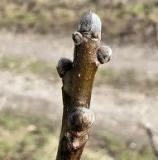 HZ-85, JUGLANS REGIA (Walnut): It is at the digestive level that the walnut is at most active, particularly in diarrhea, including those caused by taking antibiotics. It helps restore the intestinal flora and fights against abdominal meteorism. It has an action in pancreatic insufficiencies, chronic pancreatitis and is indicated in fatty diabetes of the forties. At liver level it is active in alcoholic cirrhosis and stimulates the Kupffer cells (macrophage), thus contributing to the blood purification. It can help in cases of alcoholic withdrawal because it works also at psychic level. At skin level lots of properties are reported: psoriasis, acne, scleroderma, leprosy, trichnosis, dermatomyositis, collagen, lupus erythematosus and eczema, which show that the action of the Walnut bud lies deep at the inner side for external problems. Moreover it plays a role in all hyperimmune syndromes for which some skin problems are effects but also some symptoms at osteoarticular level: evolutive chronic polyarthritis, periarthritis nodosa. At circulatory level Walnut is effective in varicose ulcers and arteritis. It works in chronic inflammations and augments the natural defences of the body. At pulmonary level Walnut combats infections of bronchial and tracheic mucosa; it is effective in certain allergic events, bronchitis and sinusitis. A recent study, conducted on 26000 people, showed a 50% reduction in the rate of heart attack among people who eat walnuts 5 times a week. Now walnuts are the only seeds containing the 3 essential fatty acids that protect the arteries (20 % oleic acid, 60 % linoleic acid, 12 to 14 % linolenic acid).
HZ-85, JUGLANS REGIA (Walnut): It is at the digestive level that the walnut is at most active, particularly in diarrhea, including those caused by taking antibiotics. It helps restore the intestinal flora and fights against abdominal meteorism. It has an action in pancreatic insufficiencies, chronic pancreatitis and is indicated in fatty diabetes of the forties. At liver level it is active in alcoholic cirrhosis and stimulates the Kupffer cells (macrophage), thus contributing to the blood purification. It can help in cases of alcoholic withdrawal because it works also at psychic level. At skin level lots of properties are reported: psoriasis, acne, scleroderma, leprosy, trichnosis, dermatomyositis, collagen, lupus erythematosus and eczema, which show that the action of the Walnut bud lies deep at the inner side for external problems. Moreover it plays a role in all hyperimmune syndromes for which some skin problems are effects but also some symptoms at osteoarticular level: evolutive chronic polyarthritis, periarthritis nodosa. At circulatory level Walnut is effective in varicose ulcers and arteritis. It works in chronic inflammations and augments the natural defences of the body. At pulmonary level Walnut combats infections of bronchial and tracheic mucosa; it is effective in certain allergic events, bronchitis and sinusitis. A recent study, conducted on 26000 people, showed a 50% reduction in the rate of heart attack among people who eat walnuts 5 times a week. Now walnuts are the only seeds containing the 3 essential fatty acids that protect the arteries (20 % oleic acid, 60 % linoleic acid, 12 to 14 % linolenic acid).
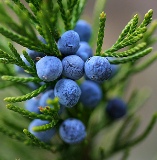 HZ-66, JUNIPERUS COMMUNIS (Juniper): Juniper young shoots extract is a remedy of the liver, indicated in hepatic insufficiency, chronic hepatitis, drug poisoning, alcoholic cirrhosis, allergies. It acts in-depth as overall tonic for the body and helps eliminating uric acid (drink very much), urea, cholesterol, sugar in blood. It is recommended in cases of atherosclerosis, various rheumatisms (chronic evolutive polyarthritis). At the level of the urinary tract it acts as a diuretic but also in cystitis, it normalizes the ionic balance, dissolves kidney stones (oxalocalcic lithiasis) and resolves edema. It presents a thrombophilic action, is active in gastric and esophageal varices. Because of its properties on kidneys, it is recommended in portal hypertension. It is also recommended in cases of cancer and specifically to help people in final phase.
HZ-66, JUNIPERUS COMMUNIS (Juniper): Juniper young shoots extract is a remedy of the liver, indicated in hepatic insufficiency, chronic hepatitis, drug poisoning, alcoholic cirrhosis, allergies. It acts in-depth as overall tonic for the body and helps eliminating uric acid (drink very much), urea, cholesterol, sugar in blood. It is recommended in cases of atherosclerosis, various rheumatisms (chronic evolutive polyarthritis). At the level of the urinary tract it acts as a diuretic but also in cystitis, it normalizes the ionic balance, dissolves kidney stones (oxalocalcic lithiasis) and resolves edema. It presents a thrombophilic action, is active in gastric and esophageal varices. Because of its properties on kidneys, it is recommended in portal hypertension. It is also recommended in cases of cancer and specifically to help people in final phase.
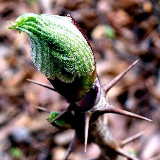 HZ-36, KALOPANAX PICTUS NAKAI (Castor Aralia): In oriental medicine, its stem bark was administered to patients to treat neurotic pain and used to treat neuralgia, rheumatic arthritis, lumbago, furuncle, carbuncles, wounds, diarrhea and scabies. Since hederagenin glycosides from Castor Aralia named kalopanaxsaponins A (1) and B (2), were isolated and the structure was determined, a number of chemical constituents such as polyacetylenic compounds, tannin, flavonoid, coumarin glycosides, alkaloid, essential oils and resin have been isolated from this plant. Castor Aralia extracts have proved to be effective in the treatment of inflammation and were shown to have a number of pharmaceutically relevant benefits that include anti-rheumatoidal, hepatoprotective, anti-diabetic, anti-cancer effects, etc.
HZ-36, KALOPANAX PICTUS NAKAI (Castor Aralia): In oriental medicine, its stem bark was administered to patients to treat neurotic pain and used to treat neuralgia, rheumatic arthritis, lumbago, furuncle, carbuncles, wounds, diarrhea and scabies. Since hederagenin glycosides from Castor Aralia named kalopanaxsaponins A (1) and B (2), were isolated and the structure was determined, a number of chemical constituents such as polyacetylenic compounds, tannin, flavonoid, coumarin glycosides, alkaloid, essential oils and resin have been isolated from this plant. Castor Aralia extracts have proved to be effective in the treatment of inflammation and were shown to have a number of pharmaceutically relevant benefits that include anti-rheumatoidal, hepatoprotective, anti-diabetic, anti-cancer effects, etc.
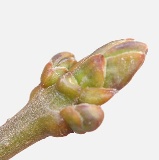 HZ-95, LIGUSTRUM VULGARE (Privet): Privet leaves are astringent; a decoction of them is very valuable in chronic bowel complaints, ulceration of stomach and bowels, as a gargle for ulcers of mouth and throat, for which it is peculiarly effective, and as an injection for ulcerated ears, with offensive discharges, leucorrhoea, gleet, and ulceration of the bladder, likewise in diabetes. They may be employed either in decoction or powder. Dose of the powdered leaves, from 30 to 60 grains, 3 times a day; of the decoction, from 2 to 4 fluid ounces.
HZ-95, LIGUSTRUM VULGARE (Privet): Privet leaves are astringent; a decoction of them is very valuable in chronic bowel complaints, ulceration of stomach and bowels, as a gargle for ulcers of mouth and throat, for which it is peculiarly effective, and as an injection for ulcerated ears, with offensive discharges, leucorrhoea, gleet, and ulceration of the bladder, likewise in diabetes. They may be employed either in decoction or powder. Dose of the powdered leaves, from 30 to 60 grains, 3 times a day; of the decoction, from 2 to 4 fluid ounces.
.
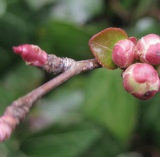 HZ-50, MALUS SYLVESTRIS (Crab apple): The fruit is astringent and laxative. The crushed fruit pulp can be used as a poultice to heal inflammations or small flesh wounds. The fruit is eaten to obviate constipation. The bark, and especially the root bark, is anthelmintic, refrigerant and soporific. An infusion is used in the treatment of intermittent, remittent and bilious fevers. The leaves contain up to 2.4% of an antibacterial substance called “florin”. This inhibits the growth of a number of gram-positive and gram-negative bacteria in as low a concentration as 30 ppm.
HZ-50, MALUS SYLVESTRIS (Crab apple): The fruit is astringent and laxative. The crushed fruit pulp can be used as a poultice to heal inflammations or small flesh wounds. The fruit is eaten to obviate constipation. The bark, and especially the root bark, is anthelmintic, refrigerant and soporific. An infusion is used in the treatment of intermittent, remittent and bilious fevers. The leaves contain up to 2.4% of an antibacterial substance called “florin”. This inhibits the growth of a number of gram-positive and gram-negative bacteria in as low a concentration as 30 ppm.
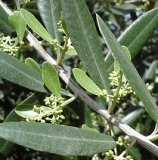 HZ-74, OLEA EUROPAEA (Olive tree): The young shoots of the Olive tree provide a great cerebral and circulatory remedy. Symbol of peace, at the same time food, excipient and remedy, multi-millenary tree, the Olive tree is famous for its oil, widely used in ointments, balms, pomades but also as excipient to extract certain liposoluble active principles (e.g. red St John’s wort oil). St Hildegarde used the bark against gout. Dr Bach recommends it in elixir form in physical psychic or intellectual overwork. The presence of olive oil, fire principle of the plant, is in relation to the action of the Olive tree in Zymotherapy. Young shoots of the Olive tree have a marked cerebral tropism which is valued in cerebral sclerosis and defects of the senile brain such as e.g. memory laps. Its action is deep as it is indicated in phobic and obsessional neurosis. Finally through its action on blood the young shoots of Olive tree is recommended in non-thrombotic cerebral atherosclerosis and arteriosclerosis. Great remedy of the circulatory system, it reduces the total lipids, cholesterol (which it destroys), balances phospholipids and thins thickened blood. Olive tree has a hypoglycemic activity which makes it indicated in fatty diabetes and diabetic arteritis, and also in tissue necrosis of the extremities leading often to gangrene. The Olive tree is also useful as anti-atherosclerotic and in thrombotic states. It is a hypotensor which does not cause vasoconstriction. Young shoots of Olive tree have moreover an action in hepatic insufficiency (olive oil is cholagogue) and in minor renal insufficiency.
HZ-74, OLEA EUROPAEA (Olive tree): The young shoots of the Olive tree provide a great cerebral and circulatory remedy. Symbol of peace, at the same time food, excipient and remedy, multi-millenary tree, the Olive tree is famous for its oil, widely used in ointments, balms, pomades but also as excipient to extract certain liposoluble active principles (e.g. red St John’s wort oil). St Hildegarde used the bark against gout. Dr Bach recommends it in elixir form in physical psychic or intellectual overwork. The presence of olive oil, fire principle of the plant, is in relation to the action of the Olive tree in Zymotherapy. Young shoots of the Olive tree have a marked cerebral tropism which is valued in cerebral sclerosis and defects of the senile brain such as e.g. memory laps. Its action is deep as it is indicated in phobic and obsessional neurosis. Finally through its action on blood the young shoots of Olive tree is recommended in non-thrombotic cerebral atherosclerosis and arteriosclerosis. Great remedy of the circulatory system, it reduces the total lipids, cholesterol (which it destroys), balances phospholipids and thins thickened blood. Olive tree has a hypoglycemic activity which makes it indicated in fatty diabetes and diabetic arteritis, and also in tissue necrosis of the extremities leading often to gangrene. The Olive tree is also useful as anti-atherosclerotic and in thrombotic states. It is a hypotensor which does not cause vasoconstriction. Young shoots of Olive tree have moreover an action in hepatic insufficiency (olive oil is cholagogue) and in minor renal insufficiency.
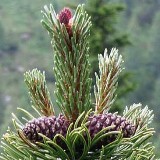 HZ-72, PINUS MONTANA (Mountain pine): The Mountain Pine bud is much related to the osteo-articular system. Remineralizing excellently it combats wear and destruction of articular cartilage (useful to reinforce a spinal column) thanks to its stimulating action on chrondocytes. Great remedy of various arthrosis forms (gonarthrosis, coxarthrosis, small joints), the Mountain Pine relieves inflammatory rheumatism, chronic arthrosic pains.
HZ-72, PINUS MONTANA (Mountain pine): The Mountain Pine bud is much related to the osteo-articular system. Remineralizing excellently it combats wear and destruction of articular cartilage (useful to reinforce a spinal column) thanks to its stimulating action on chrondocytes. Great remedy of various arthrosis forms (gonarthrosis, coxarthrosis, small joints), the Mountain Pine relieves inflammatory rheumatism, chronic arthrosic pains.
Considered as associated with the organs Kidney/Bladder of traditional Chinese medicine, it constitutes a regenerating strengthening of bones and cartilages and also for senescent syndromes characteristic of sycosis. It will be used in osteoporosis, prevention of fractures (in particular for women in post-menopausal osteoporosis). Let us also mention its properties in dystonia of the nervous system). As the Mountain Pine has many medicinal properties in traditional phytotherapy (respiratory and nervous system), we think these could be developed one day in Zymotherapy, particularly as psychical tonic.
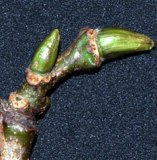 HZ-75, PLATANUS ORIENTALIS (Oriental plane tree or Platanus): The leaves are astringent and vulnerary. The fresh leaves are bruised and applied to the eyes in the treatment of ophthalmia. A decoction is used to treat dysentery and a cream made from the leaves is used to heal wounds and chilblains. The leaves are harvested in the spring and summer and can be dried for later use. The bark is boiled in vinegar and then used in the treatment of diarrhoea, dysentery, hernias and toothache. It is used in vitiligo, acne and, curiously, paludism (malarious after-effects). Its bark could involve properties against eczema, psoriasis and various intestinal disorders.
HZ-75, PLATANUS ORIENTALIS (Oriental plane tree or Platanus): The leaves are astringent and vulnerary. The fresh leaves are bruised and applied to the eyes in the treatment of ophthalmia. A decoction is used to treat dysentery and a cream made from the leaves is used to heal wounds and chilblains. The leaves are harvested in the spring and summer and can be dried for later use. The bark is boiled in vinegar and then used in the treatment of diarrhoea, dysentery, hernias and toothache. It is used in vitiligo, acne and, curiously, paludism (malarious after-effects). Its bark could involve properties against eczema, psoriasis and various intestinal disorders.
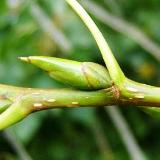 HZ-46, POPULUS NIGRA (Black poplar): The Black Poplar bud intervenes principally at the level of the circulatory sphere, as drainer of arteries. It is also related to the heart-intestine organ in traditional Chinese medicine. As such it acts in arteritis, combating its thrombophilic tendency, particularly at the level of the lower limbs. It also supports collateral circulation because of its antispasmodic arterial action. This bud has a tonic and antisclerotic action on arteries. Its overall hypocoagulating action explains partly its antiatheromatic properties on arteries, which makes it indicated in thrombotic arteritis. It is also used in gout states with rheumatic syndrome. The known properties close to those of propolis are limited to an action in tracheitis and bronchitis. Black Poplar moreover regulates the innervation of the sympathic system, cures trophic cutaneous disorders.
HZ-46, POPULUS NIGRA (Black poplar): The Black Poplar bud intervenes principally at the level of the circulatory sphere, as drainer of arteries. It is also related to the heart-intestine organ in traditional Chinese medicine. As such it acts in arteritis, combating its thrombophilic tendency, particularly at the level of the lower limbs. It also supports collateral circulation because of its antispasmodic arterial action. This bud has a tonic and antisclerotic action on arteries. Its overall hypocoagulating action explains partly its antiatheromatic properties on arteries, which makes it indicated in thrombotic arteritis. It is also used in gout states with rheumatic syndrome. The known properties close to those of propolis are limited to an action in tracheitis and bronchitis. Black Poplar moreover regulates the innervation of the sympathic system, cures trophic cutaneous disorders.
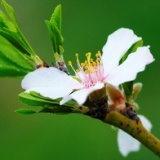 HZ-81, PRUNUS AMYGDALUS (Sweet almond): Sweet almond to combat sclerosis (principally at renal level), “thick blood” effects, triglycerides… Sweet almond has an antisclerotic action, mainly on kidney level. It lowers the rate of uric acid, urea and acts in nephrosclerosis, lipoid nephrosis and renal amyloidosis. The almond milk, well known in cosmetics, allows emulsifying greasy substances. This analogy is reflected in the bud which has the property to lower blood triglycerides and have a beneficial effect especially for hyperlipidemic and thrombophilic elderly. Further sweet almond works as a useful circulatory remedy in hypercoagulation phenomena of people with “too thick” blood and in certain disorders such as indirect coronaritis, atherosclerosis, angiosclerosis, senile arteritis. It is also helpful in hypertention and cicatrization of the myocardium after myocardial infarction. It certainly acts as preventive remedy of thrombosis. At psychic level, sweet almond is working in phobic and obsessive neurosis. It is also a thyroid stimulant. At the hepatic level, it presents antilithiasic properties in the choledochus area.
HZ-81, PRUNUS AMYGDALUS (Sweet almond): Sweet almond to combat sclerosis (principally at renal level), “thick blood” effects, triglycerides… Sweet almond has an antisclerotic action, mainly on kidney level. It lowers the rate of uric acid, urea and acts in nephrosclerosis, lipoid nephrosis and renal amyloidosis. The almond milk, well known in cosmetics, allows emulsifying greasy substances. This analogy is reflected in the bud which has the property to lower blood triglycerides and have a beneficial effect especially for hyperlipidemic and thrombophilic elderly. Further sweet almond works as a useful circulatory remedy in hypercoagulation phenomena of people with “too thick” blood and in certain disorders such as indirect coronaritis, atherosclerosis, angiosclerosis, senile arteritis. It is also helpful in hypertention and cicatrization of the myocardium after myocardial infarction. It certainly acts as preventive remedy of thrombosis. At psychic level, sweet almond is working in phobic and obsessive neurosis. It is also a thyroid stimulant. At the hepatic level, it presents antilithiasic properties in the choledochus area.
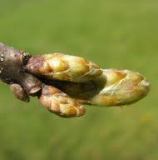 HZ-73, QUERCUS ROBUR (Oak): The properties of the oak bud are mainly directed towards the nervous and glandular system. It is a tonic recommended in sexual frigidity (often of psychological origin?); it stimulates the production of testosterone and, therefore, the activity of the testicles. It is thus useful in the male senescence, sexual asthenia, tiredness, overwork.
HZ-73, QUERCUS ROBUR (Oak): The properties of the oak bud are mainly directed towards the nervous and glandular system. It is a tonic recommended in sexual frigidity (often of psychological origin?); it stimulates the production of testosterone and, therefore, the activity of the testicles. It is thus useful in the male senescence, sexual asthenia, tiredness, overwork.
Active in the cortico-suprarenal glands, it has cortisone-like properties. Oak stimulates the pituitary gland and has a polyendocrine action. It is a tonic of the reticulo-endothelial system. It is a general stimulant of the body recommended in convalescences and denutrition. Remedy of Yang nature, it invigorates the alveolo-dental wall and is thus indicated in parodontoses and bleeding or soft gums and it heals the gingival mucosa.
Further it equilibrates tension although it is indicated in hypotension. At skin level oak is indicated in furunculosis and recurrent herpes.
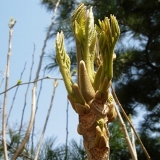 HZ-37, RHUS VERNICIFLUA STOKES (Japanese lacquer tree): Japanese lacquer tree, traditionally used as a food supplement and in traditional herbal medicine. It has been used to cure gastrointestinal diseases, pain, parasites and thrombotic disease for centuries in Korea. It is known to possess various pharmacological properties. Butein, a plant polyphenol, is one of the active components of stems of lacquer tree. Japanese lacquer tree may protect dopaminergic neurons against rotenone-induced apoptosis by multiple functions and contribute to neuroprotection in neurodegenerative diseases, such as Parkinson’s disease.
HZ-37, RHUS VERNICIFLUA STOKES (Japanese lacquer tree): Japanese lacquer tree, traditionally used as a food supplement and in traditional herbal medicine. It has been used to cure gastrointestinal diseases, pain, parasites and thrombotic disease for centuries in Korea. It is known to possess various pharmacological properties. Butein, a plant polyphenol, is one of the active components of stems of lacquer tree. Japanese lacquer tree may protect dopaminergic neurons against rotenone-induced apoptosis by multiple functions and contribute to neuroprotection in neurodegenerative diseases, such as Parkinson’s disease.
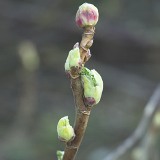 HZ-44, RIBES NIGRUM (Black currant): Blackcurrant bud is one of the most widely applicable of the extracts known in Zymotherapy. A very effective and potent tonic, it has been shown to have a salutary effect throughout the human body. It also acts as an “adaptogen”, enhancing the effect of other plants with which it may be associated.
HZ-44, RIBES NIGRUM (Black currant): Blackcurrant bud is one of the most widely applicable of the extracts known in Zymotherapy. A very effective and potent tonic, it has been shown to have a salutary effect throughout the human body. It also acts as an “adaptogen”, enhancing the effect of other plants with which it may be associated.
Blackcurrant bud is a true “natural concentrate”, effective against allergies (effect comparable to cortisone), migraines of allergic origin, urticaria, hay fever, diseases of the liver. Blackcurrant bud is at the first place an antirheumatic and a powerful anti-inflammatory. Remedy of arthrosis, gout, ligaments and tendons pains, painful joints. It is a stimulant of suprarenal glands, kidneys, pancreas and liver. It acts effectively at respiratory level in asthma, chronic bronchitis, emphysema, allergic rhinitis. Particularly recommended to tired people, lacking enthusiasm, it stimulates the endocrine glands and combats drowsiness. Also known as the yang remedy.
Remedy for the prostate, osteoporosis, gastritis, lack of appetite (one produces with fruits and buds a Blackcurrant cream that is used in several aperitifs among which kir). It is a tonicum, recommended in hypotension. The blackcurrant is indicated in any acute or chronic pathology. It also acts efficiently by internal way against the after effects of insect bites (anaphylactic shock).
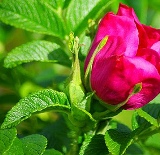 HZ-51, ROSA CANINA (Dog rose): Dog Rose is one of the principal remedies of the ENT (ear-nose-throat), sphere with its procession of diseases, as well chronic as acute: rhinitis, tonsillitis with repetition, otitis, tracheobronchitis and rhino-pharingitis. It is recommended for children with those diseases, particularly for people with tuberculinic and migrainous ground. At the level of the glandular system, Dog Rose will stimulate immunity defences (antiviral) and acts in inflammations with repetition (in particular of mucosa). It is the typical remedy for children lacking immunitary defenses and “always ill”. It can be associated with Cornus sanguinea (Dogwood) in case of thyroid adenoma. At cutaneous level, although it can act on warts, it is especially active in inflammation states. Let us note: eczema, furunculosis and herpes. It is also indicated in chronic pulmonary heart and anemia. At osteo-articular level Dog Rose is useful in disorders of child growth because it supports a harmonious schooling. It acts in the various rheumatic syndromes, particularly in gonarthrosis, of which it improves the synovial joint and calms the inflammation. As it intervenes in inflammatory states with repetition, it is, at digestive level, efficient in colitis.
HZ-51, ROSA CANINA (Dog rose): Dog Rose is one of the principal remedies of the ENT (ear-nose-throat), sphere with its procession of diseases, as well chronic as acute: rhinitis, tonsillitis with repetition, otitis, tracheobronchitis and rhino-pharingitis. It is recommended for children with those diseases, particularly for people with tuberculinic and migrainous ground. At the level of the glandular system, Dog Rose will stimulate immunity defences (antiviral) and acts in inflammations with repetition (in particular of mucosa). It is the typical remedy for children lacking immunitary defenses and “always ill”. It can be associated with Cornus sanguinea (Dogwood) in case of thyroid adenoma. At cutaneous level, although it can act on warts, it is especially active in inflammation states. Let us note: eczema, furunculosis and herpes. It is also indicated in chronic pulmonary heart and anemia. At osteo-articular level Dog Rose is useful in disorders of child growth because it supports a harmonious schooling. It acts in the various rheumatic syndromes, particularly in gonarthrosis, of which it improves the synovial joint and calms the inflammation. As it intervenes in inflammatory states with repetition, it is, at digestive level, efficient in colitis.
 HZ-77, ROSMARINUS OFFICINALIS (Rosemary): the Rosemary young shoots has a hepatoprotective action much higher (63%) than the entire plant (6%). The same is true for the biliary flow whose measurement shows a choleretic action 2 times more important for the young shoots than for the whole plant. The Rosemary can also better trap free radicals than the whole plant. Probably – but there should be experimental confirmation – others would also have such ant-oxidant properties, namely Blackcurrant and Poplar.
HZ-77, ROSMARINUS OFFICINALIS (Rosemary): the Rosemary young shoots has a hepatoprotective action much higher (63%) than the entire plant (6%). The same is true for the biliary flow whose measurement shows a choleretic action 2 times more important for the young shoots than for the whole plant. The Rosemary can also better trap free radicals than the whole plant. Probably – but there should be experimental confirmation – others would also have such ant-oxidant properties, namely Blackcurrant and Poplar.
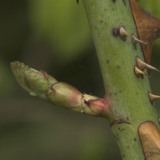 HZ-47, RUBUS FRUTICOSUS (Bramble): The Bramble young shoots present in Zymotherapy a similarity with the properties of the leaves, used in classical phytotherapy, namely a pulmonary tropism. They constitute in particular a remedy for emphysema, pulmonary fibrosis, chronic bronchitis and for all obstructive respiratory insufficiencies that lead to anergy. The Bramble is thus a long term tonic. As well in its ecological environment as at the level of our internal body, this plant will restructure the degraded ground. It is thus not surprising to find it back at the level of the osteoarticular system since it has an osteoblastic action. Bramble constitutes a remedy for important deterioration of bone tissue. It will thus strengthen the bone tissue (in particular at the femorotibial level) and combat osteoporosis. Therefore Bramble is a great potential remedy, insufficiently developed, for our “modern” populations and in particular the elderly. Its activity on fibrosclerotic tissues explains its indication in fibroids and gonarthrosis. Bramble is also indicated in interstitial nephritis following a pyelonephritis and it makes the uterus sensitive to the action of Vaccinium vitis idaia (Cowberry).
HZ-47, RUBUS FRUTICOSUS (Bramble): The Bramble young shoots present in Zymotherapy a similarity with the properties of the leaves, used in classical phytotherapy, namely a pulmonary tropism. They constitute in particular a remedy for emphysema, pulmonary fibrosis, chronic bronchitis and for all obstructive respiratory insufficiencies that lead to anergy. The Bramble is thus a long term tonic. As well in its ecological environment as at the level of our internal body, this plant will restructure the degraded ground. It is thus not surprising to find it back at the level of the osteoarticular system since it has an osteoblastic action. Bramble constitutes a remedy for important deterioration of bone tissue. It will thus strengthen the bone tissue (in particular at the femorotibial level) and combat osteoporosis. Therefore Bramble is a great potential remedy, insufficiently developed, for our “modern” populations and in particular the elderly. Its activity on fibrosclerotic tissues explains its indication in fibroids and gonarthrosis. Bramble is also indicated in interstitial nephritis following a pyelonephritis and it makes the uterus sensitive to the action of Vaccinium vitis idaia (Cowberry).
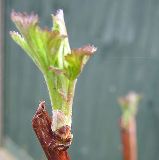 HZ-76, RUBUS IDAEUS (Rasberry): Raspberry helps to provide relief from menstrual problems, while harmonising hormone imbalance. It contributes to the well-being of women throughout the month. Traditional phytotherapy uses Raspberry leaves for respiratory diseases. Their important ellagic acid content would have anti-cancer properties. Zymotherapy employs the young shoots, before the spreading of the first leave, principally at level of the feminine hormonal system. Its action is remarkable in feminine senescence, ovarian hyalinose, dysmenorrhoea and amenorrhoea. Great regulator of the ovarian function of which it stimulates the secretion, as well of estrogen as of progesterone, raspberry is effective in late menstruation and feminine hypogonadism with puberty. It is a uterine antispasmodic which will also be active in metroragy, hematuria and painful menstruation. It is advisable to take it a few days before delivery to facilitate it. It is also recommended in post-menopause or early menopause, especially in menorrhagia. By its hormonal action, raspberry helps reduce an excessive pilosity for women, property amplified by the simultaneous use of Alchemilla vulgaris (progesterone-like). It would be interesting to verify if Raspberry presents oestrogen-like properties, which would make it a useful complement after menopause. At respiratory level Raspberry intervenes in allergies and at circulatory level, in atherosclerosis. It works in anatomo-pathologic states characterized by fibro-sclerosis. On the level of the nervous system, Raspberry exerts an antispasmodic and decontracturant action. It intervenes in neuro-vegetative imbalance, dysendocrinia and it acts in chronic inflammations like e.g. enterocolitis.
HZ-76, RUBUS IDAEUS (Rasberry): Raspberry helps to provide relief from menstrual problems, while harmonising hormone imbalance. It contributes to the well-being of women throughout the month. Traditional phytotherapy uses Raspberry leaves for respiratory diseases. Their important ellagic acid content would have anti-cancer properties. Zymotherapy employs the young shoots, before the spreading of the first leave, principally at level of the feminine hormonal system. Its action is remarkable in feminine senescence, ovarian hyalinose, dysmenorrhoea and amenorrhoea. Great regulator of the ovarian function of which it stimulates the secretion, as well of estrogen as of progesterone, raspberry is effective in late menstruation and feminine hypogonadism with puberty. It is a uterine antispasmodic which will also be active in metroragy, hematuria and painful menstruation. It is advisable to take it a few days before delivery to facilitate it. It is also recommended in post-menopause or early menopause, especially in menorrhagia. By its hormonal action, raspberry helps reduce an excessive pilosity for women, property amplified by the simultaneous use of Alchemilla vulgaris (progesterone-like). It would be interesting to verify if Raspberry presents oestrogen-like properties, which would make it a useful complement after menopause. At respiratory level Raspberry intervenes in allergies and at circulatory level, in atherosclerosis. It works in anatomo-pathologic states characterized by fibro-sclerosis. On the level of the nervous system, Raspberry exerts an antispasmodic and decontracturant action. It intervenes in neuro-vegetative imbalance, dysendocrinia and it acts in chronic inflammations like e.g. enterocolitis.
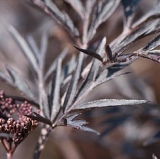 HZ-45, SAMBUCUS NIGRA (Black elder): The dried ripe berries have been eaten as a treatment for diarrhoea. A decoction of the roots has been used in the treatment of diarrhoea and dysentery. A poultice of the boiled, mashed roots has been used as a treatment for caked breasts, cuts and wounds. A decoction of the flowers has been used in the treatment of tuberculosis, coughs and colds. It has also been given to children as a spring tonic. A poultice of the crushed leaves has been used to treat bruises and bleeding wounds. Young shoots are used for kidney problems, urinary problems, increasing the production of urine and eliminating excess water from the body.
HZ-45, SAMBUCUS NIGRA (Black elder): The dried ripe berries have been eaten as a treatment for diarrhoea. A decoction of the roots has been used in the treatment of diarrhoea and dysentery. A poultice of the boiled, mashed roots has been used as a treatment for caked breasts, cuts and wounds. A decoction of the flowers has been used in the treatment of tuberculosis, coughs and colds. It has also been given to children as a spring tonic. A poultice of the crushed leaves has been used to treat bruises and bleeding wounds. Young shoots are used for kidney problems, urinary problems, increasing the production of urine and eliminating excess water from the body.
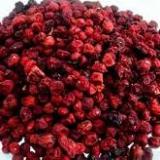 HZ-38, SCHIZANDRA CHINESIS (Five flavor berry): This woody vine is native to northeastern China, Russia, and Korea. As one of the 50 most important herbs in traditional oriental medicine, it is medically used as a general adaptogen, as a kidney and lung tonic, as well as for night sweats, insomnia, and physical exhaustion. Clinical studies have largely borne out the claims made about this herb. Side effects are uncommon. It is also known as northern five-flavor berry, and five-taste fruit. This herb is believed to increase mental and physical performance and endurance, improve vision and hearing, and decrease eye fatigue in situations where visual focus is required for extended periods of time. It is also said to help the body to cope with cold, heat, noise, and overwhelming emotions, among others. It may be given to improve circulation and as an aphrodisiac.
HZ-38, SCHIZANDRA CHINESIS (Five flavor berry): This woody vine is native to northeastern China, Russia, and Korea. As one of the 50 most important herbs in traditional oriental medicine, it is medically used as a general adaptogen, as a kidney and lung tonic, as well as for night sweats, insomnia, and physical exhaustion. Clinical studies have largely borne out the claims made about this herb. Side effects are uncommon. It is also known as northern five-flavor berry, and five-taste fruit. This herb is believed to increase mental and physical performance and endurance, improve vision and hearing, and decrease eye fatigue in situations where visual focus is required for extended periods of time. It is also said to help the body to cope with cold, heat, noise, and overwhelming emotions, among others. It may be given to improve circulation and as an aphrodisiac.
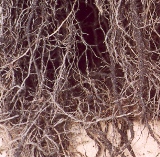 HZ-78, SECALE CEREALE (Rye): The Rootlets of Rye works essentially at hepatic level. Rye is one of the rare germinated seeds used as embryonic tissue in Zymotherapy. Its properties are little known and the plant is insufficiently studied. It works essentially at the level of the liver. It has a healing and stimulative action on the hepatocytes and constitutes thus a remedy for chronic and acute hepatitis. At cutaneous level Rye has a healing action on the skin (dermis and epidermis). It is recommended in psoriasis. It is also mentioned that it facilitates the action of immunosuppressant treatments. Let us note that germinating Rye emits in its rootlets substances which inhibit germination of other plants. It has thus a certain “antibiotic” action.
HZ-78, SECALE CEREALE (Rye): The Rootlets of Rye works essentially at hepatic level. Rye is one of the rare germinated seeds used as embryonic tissue in Zymotherapy. Its properties are little known and the plant is insufficiently studied. It works essentially at the level of the liver. It has a healing and stimulative action on the hepatocytes and constitutes thus a remedy for chronic and acute hepatitis. At cutaneous level Rye has a healing action on the skin (dermis and epidermis). It is recommended in psoriasis. It is also mentioned that it facilitates the action of immunosuppressant treatments. Let us note that germinating Rye emits in its rootlets substances which inhibit germination of other plants. It has thus a certain “antibiotic” action.
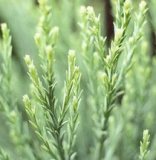 HZ-56, SEQUOIA GIGANTEA (Giant redwood): Giant Redwood (Sequoia) has a well targeted activity at both osteo-articular and nervous level. Sequoia is a useful complement for women in case of osteoporosis. Through the stimulation of the osteoblastic activity it works in the brittle bone disease (osteogenesis imperfecta, Porak and Durante disease, Lobstein disease, sclerotic blue illness) responsible for spontaneous fractures. It consolidates fractures by ensuring a better mineralization and a better vitality of the bone thread. It also contributes to make tendons and ligaments flexible. In traditional Chinese medicine both depend on the liver and Sequoia acts as a powerful hepatic drainer, useful for a congested liver. The principal and remarkable action of Giant Redwood is at level of the nervous and glandular system. Considered as a male antisenescent it contributes to an injection of youth and provides a clear feeling of well-being. It is a sexual tonic because it rebalances the spermatogenesis, stimulates immunity and slows down ageing as well on sexual as on general level. By its endocrine mobilisation it has a tonic action on intellectual level (aged brain) and an overall eutrophic action (relative to a good nutrition performance, in a normal state). Its action is slow but deep. Giant Redwood is also a prostate (adenoma) remedy. It rebalances the prostate thus assuring an appreciable urinary comfort. As Sequoia works on live (stimulates spermatogenesis) and on neurosexual functional syndromes, it is logic to think it constitutes an exceptional body tonic, as well for women as for men. Our experience confirms that and thus disadvises to take it in the evening because it can delay, even hinder, falling asleep.
HZ-56, SEQUOIA GIGANTEA (Giant redwood): Giant Redwood (Sequoia) has a well targeted activity at both osteo-articular and nervous level. Sequoia is a useful complement for women in case of osteoporosis. Through the stimulation of the osteoblastic activity it works in the brittle bone disease (osteogenesis imperfecta, Porak and Durante disease, Lobstein disease, sclerotic blue illness) responsible for spontaneous fractures. It consolidates fractures by ensuring a better mineralization and a better vitality of the bone thread. It also contributes to make tendons and ligaments flexible. In traditional Chinese medicine both depend on the liver and Sequoia acts as a powerful hepatic drainer, useful for a congested liver. The principal and remarkable action of Giant Redwood is at level of the nervous and glandular system. Considered as a male antisenescent it contributes to an injection of youth and provides a clear feeling of well-being. It is a sexual tonic because it rebalances the spermatogenesis, stimulates immunity and slows down ageing as well on sexual as on general level. By its endocrine mobilisation it has a tonic action on intellectual level (aged brain) and an overall eutrophic action (relative to a good nutrition performance, in a normal state). Its action is slow but deep. Giant Redwood is also a prostate (adenoma) remedy. It rebalances the prostate thus assuring an appreciable urinary comfort. As Sequoia works on live (stimulates spermatogenesis) and on neurosexual functional syndromes, it is logic to think it constitutes an exceptional body tonic, as well for women as for men. Our experience confirms that and thus disadvises to take it in the evening because it can delay, even hinder, falling asleep.
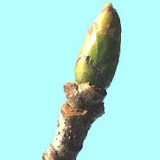 HZ-79, SORBUS DOMESTICA (Service-tree): The eatable fruits (service- or sorb-apple) are used for making various drinks. It has a very pleasant flavour, close to bitter almond or “Amaretto” liquor. Its action is remarkable on the blood system as venous drainer. It works on hyperviscosity as well as on hypocoagulation. It is ideal to combat problems of ringing ears (tinnitus), even of deafness.
HZ-79, SORBUS DOMESTICA (Service-tree): The eatable fruits (service- or sorb-apple) are used for making various drinks. It has a very pleasant flavour, close to bitter almond or “Amaretto” liquor. Its action is remarkable on the blood system as venous drainer. It works on hyperviscosity as well as on hypocoagulation. It is ideal to combat problems of ringing ears (tinnitus), even of deafness.
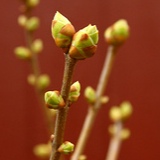 HZ-68, SYRINGA VULGARIS (Lilac): The leaves and the fruit are antiperiodic, febrifuge, tonic and vermifuge. The bark or leaves have been chewed by children as a treatment for sore mouth.
HZ-68, SYRINGA VULGARIS (Lilac): The leaves and the fruit are antiperiodic, febrifuge, tonic and vermifuge. The bark or leaves have been chewed by children as a treatment for sore mouth.
.
.
.
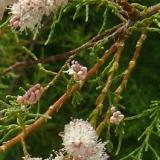 HZ-83, TAMARIX GALLICA (Tamarisk): Tamarisk activates the iron metabolism since it stimulates the formation of red blood cells. It is recommended in acute hemogenic syndromes, hypochromic anemia, as well hypoplatelet as medullary erythopenia. It acts as overall hypercoagulant and is therefore indicated in blood hypocoagulation. It is a remedy for thrombopenia acquired consequently a viral infection and is indicated in infectious mononucleosis. It combats chronic diffuse histiocytosis (Hand-Schuller disease) and activates cholesterol metabolism.
HZ-83, TAMARIX GALLICA (Tamarisk): Tamarisk activates the iron metabolism since it stimulates the formation of red blood cells. It is recommended in acute hemogenic syndromes, hypochromic anemia, as well hypoplatelet as medullary erythopenia. It acts as overall hypercoagulant and is therefore indicated in blood hypocoagulation. It is a remedy for thrombopenia acquired consequently a viral infection and is indicated in infectious mononucleosis. It combats chronic diffuse histiocytosis (Hand-Schuller disease) and activates cholesterol metabolism.
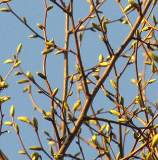 HZ-69, TILIA TOMENTOSA (Linden-tree): The bud of the Linden tree has at the same time the properties of the flower and of the sapwood, good example of the versatility of the bud compared to differentiated parts of the tree that are specialized in a determined function. This bud contains many mucilages that give greater viscosity to the fermented linden tree bud. A study showed the superiority of Tilia tomentosa on Tilia europaea at level of the sedative action. Well known for its calming action, the Linden bud is indicated in all cases of insomnia, especially among children (soft hypnotic). It constitutes the ideal pediatric remedy. The Linden tree is a remarkable drainer of the nervous system, it contributes to support the sleep, but also to increase its duration. It is recommended in neurosis (anxiety and obsessions). It is an efficient antispasmodic in cardiac palpitations, spasmophilia and diaphragmatic hernia. Taking regularly fermented linden tree bud contributes to detoxify the body, principally from cholesterol, uric acid, urea, thus relieving gout and supporting weight loss. As anti-inflammatory it is also active in chronic inflammation syndromes as gastritis and spasmodic colitis, esophageal dysphagia. At glandular level, it acts in hyperthyroiditis.
HZ-69, TILIA TOMENTOSA (Linden-tree): The bud of the Linden tree has at the same time the properties of the flower and of the sapwood, good example of the versatility of the bud compared to differentiated parts of the tree that are specialized in a determined function. This bud contains many mucilages that give greater viscosity to the fermented linden tree bud. A study showed the superiority of Tilia tomentosa on Tilia europaea at level of the sedative action. Well known for its calming action, the Linden bud is indicated in all cases of insomnia, especially among children (soft hypnotic). It constitutes the ideal pediatric remedy. The Linden tree is a remarkable drainer of the nervous system, it contributes to support the sleep, but also to increase its duration. It is recommended in neurosis (anxiety and obsessions). It is an efficient antispasmodic in cardiac palpitations, spasmophilia and diaphragmatic hernia. Taking regularly fermented linden tree bud contributes to detoxify the body, principally from cholesterol, uric acid, urea, thus relieving gout and supporting weight loss. As anti-inflammatory it is also active in chronic inflammation syndromes as gastritis and spasmodic colitis, esophageal dysphagia. At glandular level, it acts in hyperthyroiditis.
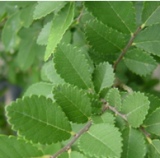 HZ-53, ULMUS CAMPESTRIS (Elm): The Elm bark was formerly considered as a panacea for skin problems. The Elm bud has a similar therapeutic profile. Great drainer of the skin the Elm has an action in oozing, vesicular, inflammatory not yet infected eczemas. It is recommended in various inflammatory skin diseases such as acne, herpes and furunculosis. Thanks to its cutaneous activity it detoxifies the body from the inside and helps reduce uric acid, cholesterol. It acts in particular on the urogenital system since it remineralises the body, solves the problems of gout, eliminates leucorrhea and relieves rheumatism. As for the bark, the buds stop diarrheas. The Elm constitutes a transition remedy which is frequently associated with other species.
HZ-53, ULMUS CAMPESTRIS (Elm): The Elm bark was formerly considered as a panacea for skin problems. The Elm bud has a similar therapeutic profile. Great drainer of the skin the Elm has an action in oozing, vesicular, inflammatory not yet infected eczemas. It is recommended in various inflammatory skin diseases such as acne, herpes and furunculosis. Thanks to its cutaneous activity it detoxifies the body from the inside and helps reduce uric acid, cholesterol. It acts in particular on the urogenital system since it remineralises the body, solves the problems of gout, eliminates leucorrhea and relieves rheumatism. As for the bark, the buds stop diarrheas. The Elm constitutes a transition remedy which is frequently associated with other species.
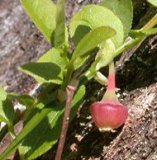 HZ-42, VACCINIUM MYRTILLUS (Bilberry): Bilberry has an important anti-diabetic action by facilitating the assimilation of sugar. By its action on the liver it improves the eyesight and in particular the capillary microcirculation. In Zymotherapy Bilberry is likely to be associated with many other buds. For us it has to be checked if the fermented young shoots of Bilberry (principally the opening terminal bud) have the same properties as those mentioned in the literature for the leaves: urinary infections and bladder stones, diarrhea, dysentery, diabetes, antigalactagogue, local application on ulcers, anti-cancer action. According to Fournier the leaves decoction has hypoglycemic properties. Allen considered Bilberry as vegetable insulin, even active in case of removed pancreas. It also provides more important tolerance for sugary food.
HZ-42, VACCINIUM MYRTILLUS (Bilberry): Bilberry has an important anti-diabetic action by facilitating the assimilation of sugar. By its action on the liver it improves the eyesight and in particular the capillary microcirculation. In Zymotherapy Bilberry is likely to be associated with many other buds. For us it has to be checked if the fermented young shoots of Bilberry (principally the opening terminal bud) have the same properties as those mentioned in the literature for the leaves: urinary infections and bladder stones, diarrhea, dysentery, diabetes, antigalactagogue, local application on ulcers, anti-cancer action. According to Fournier the leaves decoction has hypoglycemic properties. Allen considered Bilberry as vegetable insulin, even active in case of removed pancreas. It also provides more important tolerance for sugary food.
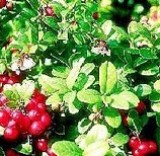 HZ-49, VACCINIUM VITIS-IDAEA (Cowberry or lingonberry): Cowberry is a plant principally female-oriented which acts as remedy for problems associated with menopause and for premature ageing in many stages of biological decompensation (acts on conjunctive hyalinosis). Cowberry grows best in acid soil, and under the worst conditions. It contains considerable amounts of oestradiol, a hormone of the female cycle and is thus recommended in menopause, as antispasmodic, in hot flashes, uterine fibroids, ovarian hyalinosis (postmenopausal), some hyalinized benign tumors (thyroid adenoma). Moreover it facilitates the absorption of calcium and therefore is useful in cases of osteoporosis. This fermented cowberry contributes to eliminate uric acid, urea, cholesterol and is an effective urinary disinfectant. It clears the renal glomeruli, removes kidney stones (oxalo-calcic lithiasis), acts in nephritis and prostate disorders. It has a diuretic action and is useful in recurrent cystitis and as drainer of the bladder. At the digestive level it is recommended in chronic constipation, spasmodic colitis (regulating action on the colon motricity), diarrhoea (especially post-antibiotic), and constitutes a remarkable intestinal drainer and disinfectant.
HZ-49, VACCINIUM VITIS-IDAEA (Cowberry or lingonberry): Cowberry is a plant principally female-oriented which acts as remedy for problems associated with menopause and for premature ageing in many stages of biological decompensation (acts on conjunctive hyalinosis). Cowberry grows best in acid soil, and under the worst conditions. It contains considerable amounts of oestradiol, a hormone of the female cycle and is thus recommended in menopause, as antispasmodic, in hot flashes, uterine fibroids, ovarian hyalinosis (postmenopausal), some hyalinized benign tumors (thyroid adenoma). Moreover it facilitates the absorption of calcium and therefore is useful in cases of osteoporosis. This fermented cowberry contributes to eliminate uric acid, urea, cholesterol and is an effective urinary disinfectant. It clears the renal glomeruli, removes kidney stones (oxalo-calcic lithiasis), acts in nephritis and prostate disorders. It has a diuretic action and is useful in recurrent cystitis and as drainer of the bladder. At the digestive level it is recommended in chronic constipation, spasmodic colitis (regulating action on the colon motricity), diarrhoea (especially post-antibiotic), and constitutes a remarkable intestinal drainer and disinfectant.
Cowberry also works on arteries and small arteries, of which it prevents the sclerosis and the degeneration of the wall. At the pulmonary level, it acts on pulmonary fibrosis, sequels of ancient pulmonary embolism. In summary the fermented cowberry (Vaccinium VI) is a general-purpose remedy, an anti-age recommended to people of the 3rd age. It is also one of the remedies of evolving chronic polyarthritis.
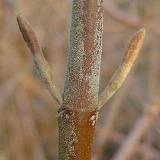 HZ-86, VIBURNUM LANTANA (Wayfaring-tree): Wayfaring tree is chiefly regarded as long drainer. As such it is used in allergic symptoms with asthmatic dyspnea, in asthma (particularly children), overinfected asthma with allergic ground, non allergic dyspnea. It has a sedative action on the neurovegetative pulmonary system and is therefore recommended in dyspneic bronchitis, chronic anergy. It inhibits bronchiolar spasm. It is a great remedy of chronic spasmodic rhinitis. Wayfaring tree is related to the Lung/ Large intestine of traditional Chinese medicine and acts on the psoric diathesis with cutaneous and respiratory alternation (an eczema “removed” by pomades often moves and is transformed in asthma). For this reason it is logical to see Wayfaring tree bud indicated in atopic eczema and eczema in inflammatory state, dermatomyositis. Its regulating action on the diencephalic- thyroid axis explains its regulating action on the thyroid. It gives also good results in hyperthyroidism. It is also useful in evolutive chronic periathritis and periarthritis nodosum.
HZ-86, VIBURNUM LANTANA (Wayfaring-tree): Wayfaring tree is chiefly regarded as long drainer. As such it is used in allergic symptoms with asthmatic dyspnea, in asthma (particularly children), overinfected asthma with allergic ground, non allergic dyspnea. It has a sedative action on the neurovegetative pulmonary system and is therefore recommended in dyspneic bronchitis, chronic anergy. It inhibits bronchiolar spasm. It is a great remedy of chronic spasmodic rhinitis. Wayfaring tree is related to the Lung/ Large intestine of traditional Chinese medicine and acts on the psoric diathesis with cutaneous and respiratory alternation (an eczema “removed” by pomades often moves and is transformed in asthma). For this reason it is logical to see Wayfaring tree bud indicated in atopic eczema and eczema in inflammatory state, dermatomyositis. Its regulating action on the diencephalic- thyroid axis explains its regulating action on the thyroid. It gives also good results in hyperthyroidism. It is also useful in evolutive chronic periathritis and periarthritis nodosum.
 HZ-71, VISCUM ALBUM (Mistletoe): Mistletoe has a multitude of medicinal properties, even if it contains a certain toxicity (mainly concentrated in the berries). Zymotherapy uses only a small part of the therapeutic potential of Mistletoe, the main indications being nevertheless valued. It is especially at cardiovascular level that Mistletoe has an antisclerotic effect. It reduces tension, cholesterol, combats atherosclerosis and dyslipidemia. It is indicated in cardiopulmonary overload (chronic pulmonary heart disease). It constitutes a remedy for ventricular hypertrophy. At nervous and glandular level, Mistletoe is appropriate in epileptic syndromes neuralgia and disorders of menopause (e.g. headaches) and andropause.
HZ-71, VISCUM ALBUM (Mistletoe): Mistletoe has a multitude of medicinal properties, even if it contains a certain toxicity (mainly concentrated in the berries). Zymotherapy uses only a small part of the therapeutic potential of Mistletoe, the main indications being nevertheless valued. It is especially at cardiovascular level that Mistletoe has an antisclerotic effect. It reduces tension, cholesterol, combats atherosclerosis and dyslipidemia. It is indicated in cardiopulmonary overload (chronic pulmonary heart disease). It constitutes a remedy for ventricular hypertrophy. At nervous and glandular level, Mistletoe is appropriate in epileptic syndromes neuralgia and disorders of menopause (e.g. headaches) and andropause.
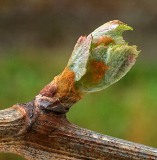 HZ-57, VITIS VINIFERA (Grape vine): The Zymotherapic action of Grape Vine lies in chronic inflammations at any level. Grape Vine has been well known for a very long time for its fruits and all by-products which result from them. People know less about the use of its leaves, its sap (eye-wash, eye-salve) and its buds. At cutaneous level Grape Vine bud constitutes a remedy for some dermatitis, erysipelas, warts and collagenosis. Most of the symptoms have an internal origin, often intestinal. At the level of the digestive system, the Vine bud acts in intestinal inflammations, such as granulomatous proctocolitis, colitis, Crohn’s ileitis. As anti-inflammatory it intervenes at circulatory level in hemorrhoids, painful phlebitis, uterine haemorrhages in menopause, painful hypermenorrhoea, adenitis (inflammation of the lymph nodes). Nevertheless it is at joints level that the anti-inflammatory properties of Vine bud apply, to the great relief of the users, especially in chronic affections such as acute joints rheumatism, various arthrosic pains, arthrosis (coxarthrosis, gonarthrosis), especially those of the small joints and those with hyperuricemia. The vine bud slows and stops joint deformations, erythema nodosum, because it inhibits ostheophytes formation. It is however active in menopause (calcium setting happens at colon level). At the level of the urogenital system the Vine bud is a remedy for fibroids, ovarian cyst, lipoidic nephrosis. At pulmonary level it constitutes an alternative to sarcoidosis and improves various polyclonal hyperimmune syndromes (autoimmune diseases, often of digestive origin). The Vine bud slows also the neo-formative process (it inhibits tumoral process) and is considered as antisycotic.
HZ-57, VITIS VINIFERA (Grape vine): The Zymotherapic action of Grape Vine lies in chronic inflammations at any level. Grape Vine has been well known for a very long time for its fruits and all by-products which result from them. People know less about the use of its leaves, its sap (eye-wash, eye-salve) and its buds. At cutaneous level Grape Vine bud constitutes a remedy for some dermatitis, erysipelas, warts and collagenosis. Most of the symptoms have an internal origin, often intestinal. At the level of the digestive system, the Vine bud acts in intestinal inflammations, such as granulomatous proctocolitis, colitis, Crohn’s ileitis. As anti-inflammatory it intervenes at circulatory level in hemorrhoids, painful phlebitis, uterine haemorrhages in menopause, painful hypermenorrhoea, adenitis (inflammation of the lymph nodes). Nevertheless it is at joints level that the anti-inflammatory properties of Vine bud apply, to the great relief of the users, especially in chronic affections such as acute joints rheumatism, various arthrosic pains, arthrosis (coxarthrosis, gonarthrosis), especially those of the small joints and those with hyperuricemia. The vine bud slows and stops joint deformations, erythema nodosum, because it inhibits ostheophytes formation. It is however active in menopause (calcium setting happens at colon level). At the level of the urogenital system the Vine bud is a remedy for fibroids, ovarian cyst, lipoidic nephrosis. At pulmonary level it constitutes an alternative to sarcoidosis and improves various polyclonal hyperimmune syndromes (autoimmune diseases, often of digestive origin). The Vine bud slows also the neo-formative process (it inhibits tumoral process) and is considered as antisycotic.
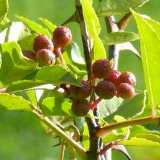 HZ-39, ZANTHOXYLUM SCHINIFOLIUM (Korean sansho): Korean sansho is an aromatic shrub with protective thorns and surprising culinary and pharmacological properties. It is anaesthetic, diuretic, parasiticide and vasodilator. It is used in the treatment of gastralgia and dyspepsia due to cold with vomiting, diarrhoea, abdominal pain, ascariasis and dermal diseases. It has a local anaesthetic action and is parasiticide against the pork tapeworm (Taenia solium). It contains geraniol. In small doses this has a mild diuretic action, though large doses will inhibit the excretion of urine. There is a persistent increase in peristalsis at low concentration, but inhibition at high concentration. The resin contained in the bark, and especially in that of the roots, is powerfully stimulant and tonic. A study confirmed that two solvent fractions from the leaves of Sansho have enhancing effects on antithrombosis and anti-inflammation partly by antioxidant action and partly by direct modulation of the respective processeds. In conclusion, Sansho leaves can be utilized as the proper ingredients of functional foods for preventing chronic degenerative disease.
HZ-39, ZANTHOXYLUM SCHINIFOLIUM (Korean sansho): Korean sansho is an aromatic shrub with protective thorns and surprising culinary and pharmacological properties. It is anaesthetic, diuretic, parasiticide and vasodilator. It is used in the treatment of gastralgia and dyspepsia due to cold with vomiting, diarrhoea, abdominal pain, ascariasis and dermal diseases. It has a local anaesthetic action and is parasiticide against the pork tapeworm (Taenia solium). It contains geraniol. In small doses this has a mild diuretic action, though large doses will inhibit the excretion of urine. There is a persistent increase in peristalsis at low concentration, but inhibition at high concentration. The resin contained in the bark, and especially in that of the roots, is powerfully stimulant and tonic. A study confirmed that two solvent fractions from the leaves of Sansho have enhancing effects on antithrombosis and anti-inflammation partly by antioxidant action and partly by direct modulation of the respective processeds. In conclusion, Sansho leaves can be utilized as the proper ingredients of functional foods for preventing chronic degenerative disease.
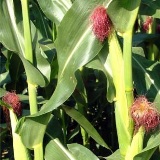 HZ-70, ZEA MAYS (Sweet corn, Maize): Maize is one of the rare germinated seeds used as embryonic tissue by Zymotherapy. A decoction of the leaves and roots is used in the treatment of strangury, dysuria and gravel. The corn silks are cholagogue, demulcent, diuretic, lithontripic, mildly stimulant and vasodilator. They also act to reduce blood sugar levels and so are used in the treatment of diabetes mellitus as well as cystitis, gonorrhoea, gout etc. The silks are harvested before pollination occurs and are best used when fresh because they tend to lose their diuretic effect when stored and also become purgative. A decoction of the cob is used in the treatment of nose bleeds and menorrhagia. The seed is diuretic and a mild stimulant. It is a good emollient poultice for ulcers, swellings and rheumatic pains, and is widely used in the treatment of cancer, tumours and warts. It contains the cell-proliferant and wound-healing substance allantoin, which is widely used in herbal medicine (especially from the herb comfrey, Symphytum officinale) to speed the healing process. The plant is said to have anticancer properties and is experimentally hypoglycaemic and hypotensive. The Maize rootlets act as anti-inflammatory on the arterial tissue and myocardium. The fermented Maize rootlets are recommended in the healing process after myocardial infarction. It is also active in coronary heart disease.
HZ-70, ZEA MAYS (Sweet corn, Maize): Maize is one of the rare germinated seeds used as embryonic tissue by Zymotherapy. A decoction of the leaves and roots is used in the treatment of strangury, dysuria and gravel. The corn silks are cholagogue, demulcent, diuretic, lithontripic, mildly stimulant and vasodilator. They also act to reduce blood sugar levels and so are used in the treatment of diabetes mellitus as well as cystitis, gonorrhoea, gout etc. The silks are harvested before pollination occurs and are best used when fresh because they tend to lose their diuretic effect when stored and also become purgative. A decoction of the cob is used in the treatment of nose bleeds and menorrhagia. The seed is diuretic and a mild stimulant. It is a good emollient poultice for ulcers, swellings and rheumatic pains, and is widely used in the treatment of cancer, tumours and warts. It contains the cell-proliferant and wound-healing substance allantoin, which is widely used in herbal medicine (especially from the herb comfrey, Symphytum officinale) to speed the healing process. The plant is said to have anticancer properties and is experimentally hypoglycaemic and hypotensive. The Maize rootlets act as anti-inflammatory on the arterial tissue and myocardium. The fermented Maize rootlets are recommended in the healing process after myocardial infarction. It is also active in coronary heart disease.
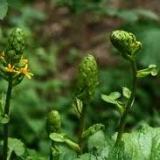 HZ-01, Ligularia fischeri (Korean Gomchi, young shoots): A well-known edible medicinal herb in Korea. It has been used to treat maladies such as jaundice, scarlet fever, rheumatoid arthritis, and hepatic function failure. Fermented young shoots of Ligularia fischeri could be used as a potential source of natural antioxidant, anticancer, and anti-inflammatory dietary supplements.
HZ-01, Ligularia fischeri (Korean Gomchi, young shoots): A well-known edible medicinal herb in Korea. It has been used to treat maladies such as jaundice, scarlet fever, rheumatoid arthritis, and hepatic function failure. Fermented young shoots of Ligularia fischeri could be used as a potential source of natural antioxidant, anticancer, and anti-inflammatory dietary supplements.
Zymotherapy complexes are preparations made up of a combination of carefully selected individual fermented bud extracts and young shoots. These blends are based on the biochemical composition of the plant buds/young shoots and on phyto-sociologic principles in order to maximize the effect of the extract in treating specific ailments.
HZ-11 Allerzym: Balances and strengthens the natural defences of the body against allergic reaction. Provide rapid relief from allergies. Stimulate the immune system. Maintain energy, without the risk of dependence.
Ribes nigrum (Black current, buds): This fermented bud extract acts as a potent anti-allergic agent, by stimulating the endocrine system (the adrenal glands in particular) resulting in an increase in circulating cortisol. Known for some time as a powerful anti-toxin, Ribes nigrum (Black current) has proved to be very effective in the treatment of all types of allergy. It acts effectively at respiratory level in asthma, chronic bron chitis, emphysema, allergic rhinitis.
Rosmarinus officinalis (Rosemary, young shoots): Acting as a powerful cleanser of liver, this fermented bud extract serves to trap free radicals, thus proving very effective in combating fatigue and somnolence, while draining and eliminating allergens.
Propolis: Known as the “Bees antibiotic”, Propolis is harvested by the bees from 솢 surface of certain buds and aromatic plants. As it contains essential oils and flavonoids, which stimulate the immune system by increasing the production of antibodies, it has an anti-viral, antibiotic and anti-allergic action, especially on the respiratory system. Propolis is a natural and effective enhancer for the action of the fermented bud extracts in this blend.
This complex can effectively replace allergy treatment using synthetic cortisone, thus avoiding unpleasant effects.
HZ-12 Arthrizym: Restores the body’s mobility and flexibility. Relieves pain and improves joint flexibility.
HZ-13 Calmerzym: The Zymo-Rescue Complex. It reduces nervousness and combats stress very quickly.
HZ-14 Coronazym: It is ideal to obtain healthy circulation and optimal blood pressure. It can be taken preventively and during long periods.
HZ-15 Cellzym: Three fermanted buds in combination can help to reduce and even eliminate cellulitis gently and progressively. Castanea vesca (Sweet chesnut) acts as a potent venous and lymphatic cleanser; Fraxinus excelsior (Ash) assists in cleansing the kidneys; while Corylus avellana (Hazel) acts in synergy to provide a long-term solution to cellulite. This complex works through the lymphatic system to more generally eliminate waste, diminish swelling, and support weight loss.
HZ-16 Choleszym: Controls your cholesterol. It helps to balance the lipid profile by stabilizing the level of “good” cholesterol (HDL) and reducing that of “bad” cholesterol (LDL). Its efficiency can still be increased by taking it with carnitine, which will act in synergy to burn undesirable fats.
Carnitine is a nutrient that helps the body turn fat into energy. It is produced by the body in the liver and kidneys and stored in the skeletal muscles, heart, brain, and sperm. Usually, the body can make all the carnitine it needs. Some people, however, may be deficient in carnitine because their bodies cannot make enough carnitine or transport it into tissues so it can be used.
HZ-17 Detoxzym: This complex serves to cleanse the body of waste matter, while helping to counteract the effects of alchohol and other toxins. It eliminates toxins directly. Cleanse the body of accumulated waste and fights against the effect of alchohol and all other toxins. Fermented young shoots of Juniperus communis (Juniper) and Rosmarinus officinalis (Rosemary) have a positive action on the liver.
HZ-18 Ginkozym: It is an integrated complex of fermented buds and leaves of Ginkgo Biloba. It acts as a real “brain and circulatory adaptogen”, improves health and shows down cell aging, particularly among the elderly.
HZ-19 Immunozym: This complex stimulates and reinforces the body’s natural defences. Through the action of three fermented bud extracts in synergy, this complex helps to strengthen the immune system, restore mineral balance by preventing demineralization, encourage bone and tooth growth.
Rosa canina (Dog rose, young shoots): This fermented bud helps to relieve respiratory problems by regulating the defence mechanisms of the body.
Abies alba (Silver fir): This fermented bud supports growth and harmonious development of all bones (remineralisation).
Ribes nigrum (Blackcurrant): This fermented bud has a tonic action on the endocrine glands and more particularly on the suprarenal glands, which allows to naturally increase the cortisol rate in blood. This cortisone-like activity gives a lasting anti-inflammatory effect and makes this complex a successful substitute for conventional anti-inflammatory drugs (cortisone) without presenting the harmful side effects of them. Moreover Blackcurrant, recognised for centuries as the most potent antidote (or counter dose), is effective in any allergic event, eliminates toxins from the body, combats aggression on the body and according to Saint Hildegarde, facilitates the action of plants associated with it. It is a general stimulant particularly recommended to tired people.
HZ-20 Neurozym: Boosts memory and increase the quality of the sleep.
HZ-21 Somnizym: For a peaceful sleep. It helps induce sleep and increase the quality of the sleep.
HZ-22 Optizym: Improves vision through enhancing microcirculation to the eyes, support for degenerative conditions of the eyes and for eye fatigue.
HZ-23 Osteozym: Focuses on building and maintaining bone health.
HZ-25 Sinuszym: This complex provides the synergic action of four fermented buds to cleanse the respiratory system. It helps breath more easily, supports most acute and chronic sinusitis, cleanse the respiratory tract, cleanse the nasal mucosa, acts as a shield against the external attacks and strengthens the body’s natural defences.
Alnus glutinosa (European alder, buds): Acts very effectively on the suppurative and inflammatory phase which allows to avoid, even to eliminate antibodies. It is indicated for all ENT problems, and more specifically for bronchitis, sinustitis, rhinitis, tracheitis and even pleuropneumonia.
Carpinus betulus (Hornbeam, buds): Acts as antispasmodic and has a specific action on the sinus mucosa. It is an excellent remedy for sinussitis, spasmodic rhinitis and chronic bronchitis.
Ribes nigrum (Blackcurrant, buds): Acts effectively at the respiratory level in asthma, chronic bronchitis, emphysema, allergic rhinitis. Furthermore, it facilitates the action of fermented buds it is associated with.
Rosa canina (Wild rose, young shoots): Constitutes one of the main remedies for all ENT problems with its variety of affections, chronic and acute as well: rhinitis, recurrent tonsillitis, otitis, tracheo-bronchitis and rhino-pharyngtitis.
HZ-26 Toniczym: Boosts energy levels. This complex is a powerful tonic, effective against fatigue and drowsiness. It also helps to drive out depression without addiction.
HZ-27 Venozym: Says good bye to heavy legs. This complex is welll known by those who suffer from heavy, painful or swollen legs.
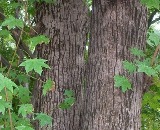 HZ-28 Acerzym: This pure non-pasturized fermented sap of Acer Mono Max (Painted maple) acts as a potent general cleanser and tonic for the body, helping to purify by draining waste matter and toxins and increasing absorbtion of minerals, vitamins and oligo-elements. The sap of Acer mono has been called ‘bone-benefit-water’ in Korea because of its mineral and sugar content. In particular, the calcium concentration of the sap of A. mono is 37·5 times higher than commercial spring water. A. mono sap could improve or prevent osteoporosis-like symptoms. The enzymatic fermented sap of A. mono ameliorates the low bone density induced by a low-calcium diet, most likely by increasing calcium ion absorption.
HZ-28 Acerzym: This pure non-pasturized fermented sap of Acer Mono Max (Painted maple) acts as a potent general cleanser and tonic for the body, helping to purify by draining waste matter and toxins and increasing absorbtion of minerals, vitamins and oligo-elements. The sap of Acer mono has been called ‘bone-benefit-water’ in Korea because of its mineral and sugar content. In particular, the calcium concentration of the sap of A. mono is 37·5 times higher than commercial spring water. A. mono sap could improve or prevent osteoporosis-like symptoms. The enzymatic fermented sap of A. mono ameliorates the low bone density induced by a low-calcium diet, most likely by increasing calcium ion absorption.
HZ-29 Maplezym: This pure fermented sap of maple and palm trees acts as a potent general cleanser and tonic for the body, helping to purify by draining waste matter and toxins. Fermented syrup mixed with lemon juice, aloe juice, ginger and cayenne pepper. Many of the claimed benefits include weight loss, cleansing the body of toxins, greater resistance to illness, improved concentration, increased energy, clearer skin and eyes, shinier hair and stronger nails.